A Comprehensive Review of Theoretical Advances, Practical Developments, and Modern Challenges of Autonomous Unmanned Ground Vehicles
Abstract
1. Introduction
1.1. General Background and Main Motivations
1.2. Definition of the Fundamental Problems of Interest for This Investigation
1.3. Scope, Methodology, and Contributions of This Work
1.4. Organization of the Manuscript
2. Historical Perspective
3. Systematic Literature Review of Modern UGVs
3.1. Methodology Overview
3.2. Implementation of the Systematic Literature Review Method
3.3. Bibliographic Analysis
4. Components of Modern Autonomous UGVs
4.1. Comparative Analysis of Tracked and Wheeled UGV Locomotion Mechanisms
4.2. Power Supply Systems for UGVs
4.3. Hardware Systems
4.4. Navigation and Control
4.5. Path Planning and Energy Optimization
5. Principal Applications
5.1. Precision Agriculture and Smart Farming
5.2. Military Scope and Defense Applications
5.3. Hazardous and Rescue Scenarios
5.4. Building and Construction Sector
6. Illustrative Example of the Powertrain Preliminary Design for a Typical UGV System
6.1. Design Strategy of a Typical UGV System
6.2. Preliminary Design of a Typical UGV System
7. Summary, Conclusions, and Future Work
7.1. Synopsis of the Review and Research Work
7.2. Current Trends, Performance Limitations, and Future Developments
7.3. Conclusive Discussion and Final Remarks
Author Contributions
Funding
Institutional Review Board Statement
Informed Consent Statement
Data Availability Statement
Conflicts of Interest
References
- Hamed, A.M.; Jayakumar, P.; Letherwood, M.D.; Gorsich, D.J.; Recuero, A.M.; Shabana, A.A. Ideal compliant joints and integration of computer aided design and analysis. J. Comput. Nonlinear Dyn. 2015, 10, 021015. [Google Scholar] [CrossRef]
- Foucault, G.; Cuillière, J.C.; François, V.; Léon, J.C.; Maranzana, R. Adaptation of CAD model topology for finite element analysis. Comput.-Aided Des. 2008, 40, 176–196. [Google Scholar] [CrossRef]
- Yoo, S.; Lee, S.; Kim, S.; Hwang, K.H.; Park, J.H.; Kang, N. Integrating deep learning into CAD/CAE system: Generative design and evaluation of 3D conceptual wheel. Struct. Multidiscip. Optim. 2021, 64, 2725–2747. [Google Scholar] [CrossRef]
- Louhichi, B.; Abenhaim, G.N.; Tahan, A.S. CAD/CAE integration: Updating the CAD model after a FEM analysis. Int. J. Adv. Manuf. Technol. 2015, 76, 391–400. [Google Scholar] [CrossRef]
- Wang, J.; Niu, W.; Ma, Y.; Xue, L.; Cun, H.; Nie, Y.; Zhang, D. A CAD/CAE-integrated structural design framework for machine tools. Int. J. Adv. Manuf. Technol. 2017, 91, 545–568. [Google Scholar] [CrossRef]
- Gujarathi, G.; Ma, Y.S. Parametric CAD/CAE integration using a common data model. J. Manuf. Syst. 2011, 30, 118–132. [Google Scholar] [CrossRef]
- Liang, H.; Chua, D.K.; Yeoh, J.K. Progress-Driven Waypoint Planning for UGV-based progress data collection and reality capture. Expert Syst. Appl. 2025, 280, 127512. [Google Scholar] [CrossRef]
- Li, Y.; Zhu, B.; Zhao, J.; Liu, Y. Terrain classification method based on fusion of vision and vehicle dynamics for UGV. Expert Syst. Appl. 2025, 279, 127495. [Google Scholar] [CrossRef]
- Shahar, F.S.; Sultan, M.T.H.; Nowakowski, M.; Łukaszewicz, A. UGV-UAV Integration Advancements for Coordinated Missions: A Review. J. Intell. Robot. Syst. 2025, 111, 69. [Google Scholar] [CrossRef]
- Anosri, S.; Panagant, N.; Champasak, P.; Bureerat, S.; Thipyopas, C.; Kumar, S.; Pholdee, N.; Yıldız, B.S.; Yildiz, A.R. A comparative study of state-of-the-art metaheuristics for solving many-objective optimization problems of fixed wing unmanned aerial vehicle conceptual design. Arch. Comput. Methods Eng. 2023, 30, 3657–3671. [Google Scholar] [CrossRef]
- Ait Saadi, A.; Soukane, A.; Meraihi, Y.; Benmessaoud Gabis, A.; Mirjalili, S.; Ramdane-Cherif, A. UAV path planning using optimization approaches: A survey. Arch. Comput. Methods Eng. 2022, 29, 4233–4284. [Google Scholar] [CrossRef]
- Sheridan, T. Telerobotics, Automation, and Human Supervisory Control, 1st ed.; MIT Press: Cambridge, MA, USA, 1992. [Google Scholar]
- Rehman, N.U.; Kumar, K.; Abro, G.e.M. Implementation of an autonomous path planning & obstacle avoidance UGV using SLAM. In Proceedings of the 2018 International Conference on Engineering and Emerging Technologies (ICEET), Lahore, Pakistan, 22–23 February 2018; pp. 1–5. [Google Scholar]
- Ni, J.; Hu, J.; Xiang, C. A review for design and dynamics control of unmanned ground vehicle. Proc. Inst. Mech. Eng. Part D J. Automob. Eng. 2021, 235, 1084–1100. [Google Scholar] [CrossRef]
- Baerveldt, A.J. Guest editorial: Agricultural robotics. Auton. Robot. 2002, 13, 5–7. [Google Scholar] [CrossRef]
- Quaglia, G.; Visconte, C.; Scimmi, L.S.; Melchiorre, M.; Cavallone, P.; Pastorelli, S. Robot arm and control architecture integration on a UGV for precision agriculture. In Proceedings of the Advances in Mechanism and Machine Science: Proceedings of the 15th IFToMM World Congress on Mechanism and Machine Science 15, Krakow, Poland, 30 June–4 July 2019; Springer: Berlin/Heidelberg, Germany, 2019; pp. 2339–2348. [Google Scholar]
- Rivera Chavez, Z.B.; Porcaro, A.; De Simone, M.C.; Guida, D. Improving Sustainable Viticulture in Developing Countries: A Case Study. Sustainability 2025, 17, 5338. [Google Scholar] [CrossRef]
- De Simone, M.C.; Veneziano, S.; Guida, D. Design of a non-back-drivable screw jack mechanism for the hitch lifting arms of electric-powered tractors. Actuators 2022, 11, 358. [Google Scholar] [CrossRef]
- Galar, D.; Kumar, U.; Seneviratne, D. Robots, Drones, UAVs and UGVs for Operation and Maintenance; CRC Press: New York, NY, USA, 2020. [Google Scholar]
- National Research Council; Division on Engineering and Physical Sciences. Technology Development for Army Unmanned Ground Vehicles; National Academies Press: Washington, DC, USA, 2003. [Google Scholar]
- Durst, P.J.; Monroe, G.; Bethel, C.L.; Anderson, D.T.; Carruth, D.W. A history and overview of mobility modeling for autonomous unmanned ground vehicles. In Proceedings of the Autonomous Systems: Sensors, Vehicles, Security, and the Internet of Everything, Orlando, FL, USA, 15–19 April 2018; SPIE: Bellingham, WA, USA, 2018; Volume 10643, pp. 103–113. [Google Scholar]
- Sharma, D.D.; Lin, J. Secure learning-based coordinated UAV–UGV framework design for medical waste transportation. Front. Remote Sens. 2024, 5, 1351703. [Google Scholar] [CrossRef]
- Asadi, K.; Suresh, A.K.; Ender, A.; Gotad, S.; Maniyar, S.; Anand, S.; Noghabaei, M.; Han, K.; Lobaton, E.; Wu, T. An integrated UGV-UAV system for construction site data collection. Autom. Constr. 2020, 112, 103068. [Google Scholar] [CrossRef]
- Shabana, A.A. Integration of computer-aided design and analysis: Application to multibody vehicle systems. Int. J. Veh. Perform. 2019, 5, 300–327. [Google Scholar] [CrossRef]
- Mikkola, A.; Shabana, A.A.; Sanchez-Rebollo, C.; Jimenez-Octavio, J.R. Comparison between ANCF and B-spline surfaces. Multibody Syst. Dyn. 2013, 30, 119–138. [Google Scholar] [CrossRef]
- Zhou, P.; Tang, S.; Liu, Y.; Zhao, J.; Sun, Z. Reconfigurable wheel-crawler-integrated walking mechanism design and kinetic analysis. Ind. Robot. Int. J. Robot. Res. Appl. 2023, 50, 633–647. [Google Scholar] [CrossRef]
- Cottrell, J.A.; Hughes, T.J.; Bazilevs, Y. Isogeometric Analysis: Toward Integration of CAD and FEA; John Wiley & Sons: New Delhi, India, 2009. [Google Scholar]
- Shabana, A.A. Geometrically accurate floating frame of reference finite elements for the small deformation problem. Proc. Inst. Mech. Eng. Part K J. Multi-Body Dyn. 2018, 232, 286–292. [Google Scholar] [CrossRef]
- Koul, P. Advancements in finite element analysis for tire performance: A comprehensive review. Int. J. Multidiscip. Res. Arts Sci. Technol. 2024, 2, 01–17. [Google Scholar] [CrossRef]
- Sanborn, G.G.; Shabana, A.A. On the integration of computer aided design and analysis using the finite element absolute nodal coordinate formulation. Multibody Syst. Dyn. 2009, 22, 181–197. [Google Scholar] [CrossRef]
- Piegl, L.; Tiller, W. The NURBS Book; Springer Science & Business Media: Berlin/Heidelberg, Germany, 2012. [Google Scholar]
- Grossi, E.; Desai, C.J.; Shabana, A.A. Development of geometrically accurate continuum-based tire models for virtual testing. J. Comput. Nonlinear Dyn. 2019, 14, 121006. [Google Scholar] [CrossRef]
- Pappalardo, C.M.; Lombardi, N.; Guida, D. A model-based system engineering approach for the virtual prototyping of an electric vehicle of class l7. Eng. Lett. 2020, 28, 215–234. [Google Scholar]
- Kuruvilla, J.K.; Seth, A.; Duttagupta, J.; Sharma, S.; Jaiswal, A. Structural Design and Analysis of 6-DOF Cylindrical Robotic Manipulators for Automated Agriculture; Apple Academic Press: Burlington, ON, Canada, 2024; pp. 147–168. [Google Scholar]
- Pappalardo, C.M.; Manca, A.G.; Guida, D. A Combined Use of the Multibody System Approach and the Finite Element Analysis for the Structural Redesign and the Topology Optimization of the Latching Component of an Aircraft Hatch Door. IAENG Int. J. Appl. Math. 2021, 51, 175–191. [Google Scholar]
- Gadola, M.; Chindamo, D.; Legnani, G.; Comini, M. Teaching automotive suspension design to engineering students: Bridging the gap between CAD and CAE tools through an integrated approach. Int. J. Mech. Eng. Educ. 2019, 47, 23–43. [Google Scholar] [CrossRef]
- Segura, C.C.; Hernandez, J.; Ramirez, H.; Aviles, O.; Mauledoux, M.; Dutra, M. Process Design for Autonomous Car Mining 1st Prototype “ACM1PT” to Help on Exploration Task on Outdoor Environments. Appl. Mech. Mater. 2016, 823, 447–452. [Google Scholar] [CrossRef]
- De Simone, M.C.; Veneziano, S.; Pace, R.; Guida, D. Multibody analysis of sloshing effect in a glass cylinder container for visual inspection activities. Appl. Sci. 2024, 14, 4522. [Google Scholar] [CrossRef]
- Yépez-Ponce, D.F.; Montalvo, W.; Guamán-Gavilanes, X.A.; Echeverría-Cadena, M.D. Route Optimization for UGVs: A Systematic Analysis of Applications, Algorithms and Challenges. Appl. Sci. 2025, 15, 6477. [Google Scholar] [CrossRef]
- Bonera, E.; Gadola, M.; Chindamo, D.; Morbioli, S.; Magri, P. Integrated design tools for model-based development of innovative vehicle chassis and powertrain systems. In Proceedings of the International Conference of the Italian Association of Design Methods and Tools for Industrial Engineering, Modena, Italy, 9–10 September 2019; Springer: Berlin/Heidelberg, Germany, 2019; pp. 118–128. [Google Scholar]
- Sharkey, N.; Sharkey, A. Electro-mechanical robots before the computer. Proc. Inst. Mech. Eng. Part C J. Mech. Eng. Sci. 2009, 223, 235–241. [Google Scholar] [CrossRef]
- Cyberneticzoo. 1914–Seleno, The Electric Dog–Hammond & Miessner. 2025. Available online: https://cyberneticzoo.com/precyber/1914-seleno-the-electric-dog-hammondmiessner/ (accessed on 28 February 2025).
- Everett, H. Unmanned Systems of World Wars I and II; MIT Press: Cambridge, MA, USA, 2015. [Google Scholar]
- Sukhopytnaya Torpeda Aubriot-Gabet: Torpille électrique (France). 2017. Available online: https://en.topwar.ru/123927-suhoputnaya-torpeda-aubriot-gabet-torpille-electrique-franciya.html (accessed on 10 January 2025).
- Marques, M.R.M. Reference Model for Interoperability of Autonomous Systems. Ph.D. Thesis, Universidade NOVA de Lisboa (Portugal), Lisbon, Portugal, 2018. [Google Scholar]
- Germain, É. De la guerre à distance à une guerre désincarnée: Les enjeux moraux d ‘une globalization du champ de bataille. Int. Rev. Red Cross 2014, 95, 28. [Google Scholar]
- Cooke, T. A Timeline of Military Robots and Drones; Capstone: North Mankato, MN, USA, 2017. [Google Scholar]
- Rondelli, V.; Franceschetti, B.; Mengoli, D. A review of current and historical research contributions to the development of ground autonomous vehicles for agriculture. Sustainability 2022, 14, 9221. [Google Scholar] [CrossRef]
- Larcombe, M. Mobile robots for industrial use. Ind. Robot. Int. J. 1979, 6, 70–76. [Google Scholar] [CrossRef]
- Marce, L.; Julliere, M.; Place, H.; Perrichot, H. A semi-autonomous remote controlled mobile robot. Ind. Robot. Int. J. 1980, 7, 232–235. [Google Scholar] [CrossRef]
- Heer, E. The Role of Robots and Automation in Space; Technical Report; Jet Propulsion Laboratory, California Institute of Technology: Pasadena, CA, USA, 1978. [Google Scholar]
- Center, A.I. Shakey the Robot; SRI International Artificial Intelligence Center, Computer Science and Technology Division: Menlo Park, CA, USA, 1984. [Google Scholar]
- Orlando, N.E. An intelligent robotics control scheme. In Proceedings of the 1984 American Control Conference, San Diego, CA, USA, 6–8 June 1984; pp. 204–209. [Google Scholar]
- Giralt, G.; Chatila, R.; Vaisset, M. An integrated navigation and motion control system for autonomous multisensory mobile robots. In Autonomous Robot Vehicles; Springer: New York, NY, USA, 1990; pp. 420–443. [Google Scholar]
- Nilsson, N.J. A mobius automation: An application of artificial intelligence techniques. In Proceedings of the 1st International Joint Conference on Artificial Intelligence, IJCAI, Citeseer, Washington, DC, USA, 7–9 May 1969; Volume 69, pp. 509–520. [Google Scholar]
- Odedra, S.; Prior, S.D.; Karamanoglu, M. Investigating the Mobility of Unmanned Ground Vehicles. In Proceedings of the International Conference on Manufacturing and Engineering Systems, Huwei, Taiwan, 17–19 December 2009. [Google Scholar]
- Yerazunis, S. Autonomous Control of Roving Vehicles for Unmanned Exploration of the Planets; Technical Report; Rensselaer Polytechnic Institute: Troy, NY, USA, 1978. [Google Scholar]
- Doig, G.A. Electronic and Software Subsystems for an Autonomous Roving Vehicle; Technical Report; Rensselaer Polytechnic Institute: Troy, NY, USA, 1980. [Google Scholar]
- Lowrie, J.W.; Thomas, M.; Gremban, K.; Turk, M. The autonomous land vehicle (ALV) preliminary road-following demonstration. In Proceedings of the Intelligent Robots and Computer Vision IV; SPIE: Bellingham, WA, USA, 1985; Volume 579, pp. 336–350. [Google Scholar]
- Turk, M.; Morgenthaler, D.; Gremban, K.; Marra, M. Video road-following for the autonomous land vehicle. In Proceedings of the 1987 IEEE International Conference on Robotics and Automation, Raleigh, NC, USA, 31 March –3 April 1987; Volume 4, pp. 273–280. [Google Scholar]
- Turk, M.A.; Morgenthaler, D.G.; Gremban, K.D.; Marra, M. VITS-A vision system for autonomous land vehicle navigation. IEEE Trans. Pattern Anal. Mach. Intell. 1988, 10, 342–361. [Google Scholar] [CrossRef]
- Torii, T. Research in autonomous agriculture vehicles in Japan. Comput. Electron. Agric. 2000, 25, 133–153. [Google Scholar] [CrossRef]
- Shoemaker, C.M.; Bornstein, J.A. The Demo III UGV program: A testbed for autonomous navigation research. In Proceedings of the 1998 IEEE International Symposium on Intelligent Control (ISIC) Held Jointly with IEEE International Symposium on Computational Intelligence in Robotics and Automation (CIRA) Intell., Gaithersburg, MD, USA, 17 September 1998; pp. 644–651. [Google Scholar]
- Lane, G.R.; Lescoe, P.; Cooper, S. Unmanned ground vehicle control technology. In Proceedings of the NTC’91-National Telesystems Conference Proceedings, Atlanta, GA, USA, 26–27 March 1991; p. 329. [Google Scholar]
- Kumar, S.; Khan, G. Self controlled robot for military purpose. Int. J. Technol. Res. Eng. 2014, 1, 2347–4718. [Google Scholar]
- FLIR. PackBot-Unmanned Ground System. 2025. Available online: https://defense.flir.com/defense-products/packbot-525/ (accessed on 28 February 2025).
- Lindemann, R.A.; Voorhees, C.J. Mars Exploration Rover mobility assembly design, test and performance. In Proceedings of the 2005 IEEE International Conference on Systems, Man and Cybernetics, Waikoloa, HI, USA, 12 October 2005; Volume 1, pp. 450–455. [Google Scholar]
- NASA. Mars Exploration Rovers: Spirit and Opportunity. 2025. Available online: https://science.nasa.gov/mission/mars-exploration-rovers-spirit-and-opportunity/ (accessed on 15 January 2025).
- Zakrajsek, J.; McKissock, D.; Woytach, J.; Zakrajsek, J.; Oswald, F.; McEntire, K.; Hill, G.; Abel, P.; Eichenberg, D.; Goodnight, T. Exploration rover concepts and development challenges. In Proceedings of the 1st Space Exploration Conference: Continuing the Voyage of Discovery, Orlando, FL, USA, 30 January–1 February 2005; p. 2525. [Google Scholar]
- Braid, D.; Broggi, A.; Schmiedel, G. The TerraMax autonomous vehicle. J. Field Robot. 2006, 23, 693–708. [Google Scholar] [CrossRef]
- Ozguner, U.; Redmill, K.A.; Broggi, A. Team TerraMax and the DARPA grand challenge: A general overview. In Proceedings of the IEEE Intelligent Vehicles Symposium, Parma, Italy, 14–17 June 2004; pp. 232–237. [Google Scholar]
- ELÁŠ, J.; RAÚSOÁ, D. Trends of development in unmanned military motor vehicles. Univ. Rev. 2013, 7, 8–14. [Google Scholar]
- Blokhin, A.; Koshurina, A.; Krasheninnikov, M.; Dorofeev, R. The analytical review of the condition of heavy class military and dual-purpose unmanned ground vehicle. In Proceedings of the MATEC Web of Conferences. EDP Sciences, Lille, France, 6–11 July 2015; Volume 26, p. 04002. [Google Scholar]
- Czapla, T.; Wrona, J. Technology development of military applications of unmanned ground vehicles. In Vision Based Systemsfor UAV Applications; Springer: Heidelberg, Germany, 2013; pp. 293–309. [Google Scholar]
- Azmat, M.; Kummer, S. Potential applications of unmanned ground and aerial vehicles to mitigate challenges of transport and logistics-related critical success factors in the humanitarian supply chain. Asian J. Sustain. Soc. Responsib. 2020, 5, 3. [Google Scholar] [CrossRef]
- Moher, D.; Liberati, A.; Tetzlaff, J.; Altman, D.G. Preferred reporting items for systematic reviews and meta-analyses: The PRISMA statement. Int. J. Surg. 2010, 8, 336–341. [Google Scholar] [CrossRef]
- Aria, M.; Cuccurullo, C. bibliometrix: An R-tool for comprehensive science mapping analysis. J. Inf. 2017, 11, 959–975. [Google Scholar] [CrossRef]
- Tokekar, P.; Vander Hook, J.; Mulla, D.; Isler, V. Sensor planning for a symbiotic UAV and UGV system for precision agriculture. IEEE Trans. Robot. 2016, 32, 1498–1511. [Google Scholar] [CrossRef]
- Li, J.; Deng, G.; Luo, C.; Lin, Q.; Yan, Q.; Ming, Z. A hybrid path planning method in unmanned air/ground vehicle (UAV/UGV) cooperative systems. IEEE Trans. Veh. Technol. 2016, 65, 9585–9596. [Google Scholar] [CrossRef]
- Lattanzi, D.; Miller, G. Review of robotic infrastructure inspection systems. J. Infrastruct. Syst. 2017, 23, 04017004. [Google Scholar] [CrossRef]
- Carlson, J.; Murphy, R.R. How UGVs physically fail in the field. IEEE Trans. Robot. 2005, 21, 423–437. [Google Scholar] [CrossRef]
- Yoon, Y.; Shin, J.; Kim, H.J.; Park, Y.; Sastry, S. Model-predictive active steering and obstacle avoidance for autonomous ground vehicles. Control Eng. Pract. 2009, 17, 741–750. [Google Scholar] [CrossRef]
- Yu, H.; Meier, K.; Argyle, M.; Beard, R.W. Cooperative path planning for target tracking in urban environments using unmanned air and ground vehicles. IEEE/ASME Trans. Mechatronics 2014, 20, 541–552. [Google Scholar] [CrossRef]
- Torok, M.M.; Golparvar-Fard, M.; Kochersberger, K.B. Image-based automated 3D crack detection for post-disaster building assessment. J. Comput. Civ. Eng. 2014, 28, A4014004. [Google Scholar] [CrossRef]
- Wong, J.Y.; Huang, W. “Wheels vs. tracks”—A fundamental evaluation from the traction perspective. J. Terramech. 2006, 43, 27–42. [Google Scholar] [CrossRef]
- Qin, H.; Meng, Z.; Meng, W.; Chen, X.; Sun, H.; Lin, F.; Ang, M.H. Autonomous exploration and mapping system using heterogeneous UAVs and UGVs in GPS-denied environments. IEEE Trans. Veh. Technol. 2019, 68, 1339–1350. [Google Scholar] [CrossRef]
- Manrique, C.; Pappalardo, C.; Guida, D. On the Analytical and Computational Methodologies for Modelling Two-wheeled Vehicles within the Multibody Dynamics Framework: A Systematic Literature Review. J. Appl. Comput. Mech. 2021, 8, 153–181. [Google Scholar] [CrossRef]
- Pérez Carrera, C.; Genel, Ö.E.; La Regina, R.; Pappalardo, C.M.; Guida, D. A comprehensive and systematic literature review on flying cars in contemporary research. J. Appl. Comput. Mech. 2025, 11, 642–666. [Google Scholar]
- Typiak, A. Requirements for mobility of platforms and power supply system for unmanned ground vehicles. J. KONES 2009, 16, 457–464. [Google Scholar]
- Colyer, R.; Economou, J. Comparison of steering geometries for multi-wheeled vehicles by modelling and simulation. In Proceedings of the 37th IEEE Conference on Decision and Control (Cat. No. 98CH36171), Tampa, FL, USA, 16–18 December 1998; Volume 3, pp. 3131–3133. [Google Scholar]
- Zhang, S.; Vantsevich, V.V. Turnability of a small UGV with individual wheel skid-steering on soft terrain. In Proceedings of the International Design Engineering Technical Conferences and Computers and Information in Engineering Conference, Quebec City, QC, Cananda, 26–29 August 2018; American Society of Mechanical Engineers: New York, NY, USA, 2018; Volume 51784, p. V003T01A017. [Google Scholar]
- Tran, T.H.; Kwok, N.M.; Scheding, S.; Ha, Q.P. Dynamic modelling of wheel-terrain interaction of a UGV. In Proceedings of the 2007 IEEE International Conference on Automation Science and Engineering, Scottsdale, AZ, USA, 22–25 September 2007; pp. 369–374. [Google Scholar]
- Narvesen, A.; Selekwa, M.F. Dynamics and Control of Four Wheeled Differentially Steered UGVs. In Proceedings of the ASME International Mechanical Engineering Congress and Exposition, Montreal, QC, Canada, 14–20 November 2014; Volume 46476, p. V04AT04A034. [Google Scholar]
- Baril, D.; Grondin, V.; Deschênes, S.P.; Laconte, J.; Vaidis, M.; Kubelka, V.; Gallant, A.; Giguere, P.; Pomerleau, F. Evaluation of skid-steering kinematic models for subarctic environments. In Proceedings of the 2020 17th Conference on Computer and Robot Vision (CRV), Ottawa, ON, Canada, 13–15 May 2020; pp. 198–205. [Google Scholar]
- Zhang, J.; Li, W.; Yan, J.; Shan, L. A Comparative Study of Ackermann Two-Axle Steering and Skid-Steering Mechanisms for Unmanned Ground Vehicles. In Proceedings of the International Conference on Autonomous Unmanned Systems, Nanjing, China, 9–11 September 2023; Springer: Berlin/Heidelberg, Germany, 2023; pp. 332–341. [Google Scholar]
- Lee, J.Y.; Han, S.; Kim, M.; Seo, Y.S.; Park, J.; Park, D.I.; Park, C.; Seo, H.; Lee, J.; Kim, H.S.; et al. Variable-stiffness–morphing wheel inspired by the surface tension of a liquid droplet. Sci. Robot. 2024, 9, eadl2067. [Google Scholar] [CrossRef] [PubMed]
- Jia, Z.; Smith, W.; Peng, H. Terramechanics-based wheel–terrain interaction model and its applications to off-road wheeled mobile robots. Robotica 2012, 30, 491–503. [Google Scholar] [CrossRef]
- Staicu, S. Dynamics equations of a mobile robot provided with caster wheel. Nonlinear Dyn. 2009, 58, 237–248. [Google Scholar] [CrossRef]
- Robo-Dyne. 4WD eXplorer: Four-Wheel-Driving Steering Robot Vehicle. 2024. Available online: https://robodyne-services.com/explorer-4wd-ugv-four-wheel-driving-steering-robot-vehicle/ (accessed on 13 December 2024).
- Samarini, E.; Shabana, A.A.; Grossi, E.; Somà, A. Integration of geometry and analysis for the study of continuum-based airless tyres of planetary wheeled robots. Int. J. Veh. Perform. 2020, 6, 446–480. [Google Scholar] [CrossRef]
- Sekhar, G.C.; Anjaneyulu, B.; Rao, K.; Rao, G.N. Design and analysis of four wheeler airless tire. Int. J. Eng. Sci. 2016, 6, 3365–3379. [Google Scholar]
- Patel, M.D.; Pappalardo, C.M.; Wang, G.; Shabana, A.A. Integration of geometry and small and large deformation analysis for vehicle modelling: Chassis, and airless and pneumatic tyre flexibility. Int. J. Veh. Perform. 2019, 5, 90–127. [Google Scholar] [CrossRef]
- Blundell, M.; Harty, D. The Multibody Systems Approach to Vehicle Dynamics; Elsevier: Oxford, UK, 2004. [Google Scholar]
- Shabana, A.A. Dynamics of Multibody Systems; Cambridge University Press: Cambridge, UK, 2020. [Google Scholar]
- Shabana, A.A. Computational Continuum Mechanics; John Wiley & Sons: Hoboken, NJ, USA, 2018. [Google Scholar]
- Samarini, E. Development of ANCF Airless Tire Model for the Mars Rover. Master’s Thesis, University of Illinois at Chicago, Chicago, IL, USA, 2020. [Google Scholar]
- Huang, G.; Yang, Z. Dynamic simulation of a rigid-flexible coupling positioning stage base on modified floating frame of reference formulation. In Proceedings of the 2nd International Conference on Applied Mathematics, Modelling, and Intelligent Computing (CAMMIC 2022), Kunming, China, 25–17 March 2022; SPIE: Bellingham, WA, USA, 2022; Volume 12259, pp. 721–727. [Google Scholar]
- Dickerson, S.L.; Lapin, B.D. Control of an omni-directional robotic vehicle with Mecanum wheels. In Proceedings of the NTC’91-National Telesystems Conference Proceedings, Atlanta, GA, USA, 26–17 March 1991; pp. 323–328. [Google Scholar]
- Abd Mutalib, M.A.; Azlan, N.Z. Prototype development of mecanum wheels mobile robot: A review. Appl. Res. Smart Technol. (ARSTech) 2020, 1, 71–82. [Google Scholar] [CrossRef]
- Park, I.; Pi, Y.; Park, J.; Kim, H.S.; Seo, T. Robust Optimal Design of a Shape-Morphing Wheel with High Speed Locomotion. Int. J. Precis. Eng. Manuf. 2025, 26, 1–11. [Google Scholar] [CrossRef]
- Sidi, M.H.A.; Hudha, K.; Abd Kadir, Z.; Amer, N.H. Modeling and path tracking control of a tracked mobile robot. In Proceedings of the 2018 IEEE 14th International Colloquium on Signal Processing & Its Applications (CSPA), Penang, Malaysia, 9–10 March 2018; pp. 72–76. [Google Scholar]
- Bruzzone, L.; Nodehi, S.E.; Fanghella, P. Tracked locomotion systems for ground mobile robots: A review. Machines 2022, 10, 648. [Google Scholar] [CrossRef]
- Fiedeń, M.; Bałchanowski, J. A mobile robot with omnidirectional tracks—Design and experimental research. Appl. Sci. 2021, 11, 11778. [Google Scholar] [CrossRef]
- Chen, P.; Mitsutake, S.; Isoda, T.; Shi, T. Omni-directional robot and adaptive control method for off-road running. IEEE Trans. Robot. Autom. 2002, 18, 251–256. [Google Scholar] [CrossRef]
- Ernits, R.M.; Hoppe, N.; Kuznetsov, I.; Uriarte, C.; Freitag, M. A new omnidirectional track drive system for off-road vehicles. In Proceedings of the XXII International Conference on Material Handling, Constructions and Logistics, Belgrade, Serbia, 4–6 October 2017. [Google Scholar]
- Teramoto, E.; Yabe, F.; Fukushima, K.; Narahara, H.; Kiyono, Y.; Togasi, S.; Kadono, M.; Nishimura, N.; Muramatsu, T. Development of a high-speed, half-tracked truck with metal-coreless rubber track. J. Terramech. 1996, 33, 113–123. [Google Scholar] [CrossRef]
- Grazioso, A.; Galati, R.; Mantriota, G.; Reina, G. Multibody simulation of a novel tracked robot with innovative passive suspension. In Proceedings of the International Conference of IFToMM ITALY, Naples, Italy, 7–9 September 2022; Springer: Berlin/Heidelberg, Germany, 2022; pp. 139–146. [Google Scholar]
- Liu, W.; Luo, X.; Zeng, S.; Zeng, L.; Wen, Z. The Design and Test of the Chassis of a Triangular Crawler-Type Ratooning Rice Harvester. Agriculture 2022, 12, 890. [Google Scholar] [CrossRef]
- Lawton, D.T.; Levitt, T.S.; McConnell, C.; Glicksman, J. Terrain models for an autonomous land vehicle. In Readings in Computer Vision; Elsevier: San Francisco, CA, USA, 1987; pp. 483–491. [Google Scholar]
- Crisan, A.V.; Morariu-Gligor, R.M. A study on the impact force in case of tamping rammers. Rom. J. Acoust. Vib. 2019, 16, 78–83. [Google Scholar]
- He, R.; Sandu, C.; Khan, A.K.; Guthrie, A.G.; Els, P.S.; Hamersma, H.A. Review of terramechanics models and their applicability to real-time applications. J. Terramech. 2019, 81, 3–22. [Google Scholar] [CrossRef]
- Tsitouridis, G. Terramechanics and Soil–Wheel Interactions for Road Vehicle Applications. Ph.D. Thesis, Loughborough University, Loughborough, UK, 2019. [Google Scholar]
- Jinzheng, Z.; Qi, W.; Qichun, J.; Peng, Z. Simulation Analysis of Interaction Mechanism Between Triangular Track and Ground Based on Bekker Theory. Acta Technica 62 No. 2B/2017, 1120 c 2017 Institute of Thermomechanics CAS, v.v.i. Available online: http://journal.it.cas.cz (accessed on 9 November 2025).
- Zhang, R.; Zhou, W.; Liu, H.; Gong, J.; Chen, H.; Khajepour, A. Similarities between Wheels and Tracks: A “Tire Model” for Tracked Vehicles. IEEE Trans. Veh. Technol. 2024, 73, 16416–16431. [Google Scholar] [CrossRef]
- Johnson, J.B.; Kulchitsky, A.V.; Duvoy, P.; Iagnemma, K.; Senatore, C.; Arvidson, R.E.; Moore, J. Discrete element method simulations of Mars Exploration Rover wheel performance. J. Terramech. 2015, 62, 31–40. [Google Scholar] [CrossRef]
- Jaiswal, S.; Korkealaakso, P.; Åman, R.; Sopanen, J.; Mikkola, A. Deformable terrain model for the real-time multibody simulation of a tractor with a hydraulically driven front-loader. IEEE Access 2019, 7, 172694–172708. [Google Scholar] [CrossRef]
- Kulju, S.; Ala-Ilomäki, J. Integration soil contact model—A flexible pressure-sinkage method for simulating low speed vehicles with wheels and tracks. Soil Tillage Res. 2025, 246, 106312. [Google Scholar] [CrossRef]
- Schäfer, B.; Gibbesch, A.; Krenn, R.; Rebele, B. Planetary rover mobility simulation on soft and uneven terrain. Veh. Syst. Dyn. 2010, 48, 149–169. [Google Scholar] [CrossRef]
- Taghavifar, H.; Rakheja, S. A novel terramechanics-based path-tracking control of terrain-based wheeled robot vehicle with matched-mismatched uncertainties. IEEE Trans. Veh. Technol. 2019, 69, 67–77. [Google Scholar] [CrossRef]
- Zhou, F.; Arvidson, R.E.; Bennett, K.; Trease, B.; Lindemann, R.; Bellutta, P.; Iagnemma, K.; Senatore, C. Simulations of mars rover traverses. J. Field Robot. 2014, 31, 141–160. [Google Scholar] [CrossRef]
- Acquah, K.; Chen, Y. Soil compaction from wheel traffic under three tillage systems. Agriculture 2022, 12, 219. [Google Scholar] [CrossRef]
- Bugár, M.; Stanák, V.; Ferencey, V. Hybrid powertrain conceptual design for unmanned ground vehicle. Sci. Mil. J. 2011, 6, 13. [Google Scholar]
- Salama, M.A.; Vantsevich, V.V.; Way, T.R.; Gorsich, D.J. UGV with a distributed electric driveline: Controlling for maximum slip energy efficiency on stochastic terrain. J. Terramech. 2018, 79, 41–57. [Google Scholar] [CrossRef]
- Broderick, J.; Hartner, J.; Tilbury, D.M.; Atkins, E.M. Modeling and simulation of an unmanned ground vehicle power system. In Proceedings of the Unmanned Systems Technology XVI, Baltimore, ML, USA, 5–8 May 2014; SPIE: Bellingham, WA, USA, 2014; Volume 9084, pp. 46–55. [Google Scholar]
- Baldic, J.; Osenar, P.; Lauder, N.; Launie, P. Fuel cell systems for long duration electric UAVs and UGVs. In Proceedings of the Defense Transformation and Net-Centric Systems, Orlando, FL, USA, 12–16 April 2010; SPIE: Bellingham, WA, USA, 2010; Volume 7707, pp. 9–17. [Google Scholar]
- Bugár, M.; Ferencey, V. Control management system of the hybrid—Electric power sources simulation for unmanned ground vehicle. In Proceedings of the 2016 Cybernetics & Informatics (K&I), Orlando, FL, USA, 5–8 July 2016; pp. 1–6. [Google Scholar]
- González, E.L.; Cuesta, J.S.; Fernandez, F.J.V.; Llerena, F.I.; Carlini, M.A.R.; Bordons, C.; Hernandez, E.; Elfes, A. Experimental evaluation of a passive fuel cell/battery hybrid power system for an unmanned ground vehicle. Int. J. Hydrogen Energy 2019, 44, 12772–12782. [Google Scholar] [CrossRef]
- Barreras, F.; Maza, M.; Lozano, A.; Báscones, S.; Roda, V.; Barranco, J.E.; Cerqueira, M.; Vergés, A. Design and development of a multipurpose utility AWD electric vehicle with a hybrid powertrain based on PEM fuel cells and batteries. Int. J. Hydrogen Energy 2012, 37, 15367–15379. [Google Scholar] [CrossRef]
- Farella, A.; Paciolla, F.; Quartarella, T.; Pascuzzi, S. Agricultural unmanned ground vehicle (UGV): A brief overview. In Proceedings of the International Symposium on Farm Machinery and Processes Management in Sustainable Agriculture, Lublin, Poland, 12–14 June 2024; Springer: Berlin/Heidelberg, Germany, 2024; pp. 137–146. [Google Scholar]
- Guo, L.; Zhang, X.; Zou, Y.; Han, L.; Du, G.; Guo, N.; Xiang, C. Co-optimization strategy of unmanned hybrid electric tracked vehicle combining eco-driving and simultaneous energy management. Energy 2022, 246, 123309. [Google Scholar] [CrossRef]
- Tan, Y.; Xu, J.; Ma, J.; Li, Z.; Chen, H.; Xi, J.; Liu, H. A transferable perception-guided EMS for series hybrid electric unmanned tracked vehicles. Energy 2024, 306, 132367. [Google Scholar] [CrossRef]
- Minh, T.B.; Luan, H.T.; Nhu, T.Q.; Duong, B.M. MiniRos: An autonomous UGV robot for education and research. In Proceedings of the 2021 International Conference on System Science and Engineering (ICSSE), Nha Trang City, Vietnam, 26–28 August 2021; pp. 170–175. [Google Scholar]
- Arana, G.; Garcia, A.; Nguyen, J.; Velazquez, A. Final Design Report: NavG – NGCP. California Polytechnic State University, San Luis Obispo, CA, USA. Northrop Grumman Collaboration Project (NGCP) Capstone Report. 2020. Available online: https://www.justinnuwin.com/projects/cp-capstone/report.pdf (accessed on 9 November 2025).
- Teskeredzic, E.; Akagic, A. Low cost UGV platform for autonomous 2D navigation and map-building based on a single sensory input. In Proceedings of the 2020 7th International Conference on Control, Decision and Information Technologies (CoDIT), Prague, Czech Republic, 29 June–2 July 2020; Volume 1, pp. 988–993. [Google Scholar]
- Mudassir Ahmad, M.; Ahuja, K.; Nayyar, A. Hybrid Single Board Computer System for Unmanned Ground Vehicle. In Proceedings of the 2022 7th International Conference on Intelligent Information Technology, Foshan, China, 25–27 February 2022; pp. 106–112. [Google Scholar]
- Chang, C.C.; Juan, Y.H.; Huang, C.L.; Chen, H.J. Scenario analysis for road following using jetbot. In Proceedings of the 2020 IEEE Eurasia Conference on IOT, Communication and Engineering (ECICE), Yunlin, Taiwan, 23–25 October 2020; pp. 403–406. [Google Scholar]
- Atar, S.; Shaikh, A. Amphibious self-balancing autonomous surveillance UGV. Int. Res. J. Eng. Technol. (IRJET) 2021, 8, 1848–1854. [Google Scholar]
- Hu, Y.; Li, D.; He, Y.; Han, J. Path planning of UGV based on Bézier curves. Robotica 2019, 37, 969–997. [Google Scholar] [CrossRef]
- Li, P.; Li, W.; Cui, Z.; Yang, P.; Chen, C.; You, B.; Wang, J. UGV Navigation in Complex Environment: An Approach Integrating Security Detection and Obstacle Avoidance Control. IEEE Trans. Intell. Veh. 2025, 10, 4727–4741. [Google Scholar] [CrossRef]
- Liu, W.; Kim, S.W.; Pendleton, S.; Ang, M.H. Situation-aware decision making for autonomous driving on urban road using online POMDP. In Proceedings of the 2015 IEEE Intelligent Vehicles Symposium (IV), Seoul, Republic of Korea, 28 June–1 July 2015; pp. 1126–1133. [Google Scholar]
- Qin, L.; Yang, A.; Li, J.; Li, Y.; Feng, Y.; Liu, L. Review and outlook of decision-making methods in unmanned ground vehicles. In Proceedings of the International Conference on Autonomous Unmanned Systems, Changsha, China, 24–26 September 2021; Springer: Berlin/Heidelberg, Germany, 2021; pp. 2931–2941. [Google Scholar]
- Yongshen, L.; Xuerong, Y.; Yajun, Y.; Shengdong, P. Formation control of UGVs based on artificial potential field. In Proceedings of the 2018 37th Chinese Control Conference (CCC), Wuhan, China, 25–27 July 2018; pp. 6830–6835. [Google Scholar]
- Tanveer, A.; Ashraf, M.T.; Khan, U. Motion Planning for Autonomous Ground Vehicles Using Artificial Potential Fields: A Review. arXiv 2023, arXiv:2310.14339. [Google Scholar] [CrossRef]
- Gong, T.; Yu, Y.; Song, J. Path planning for multiple unmanned vehicles (MUVs) formation shape generation based on dual RRT optimization. Actuators 2022, 11, 190. [Google Scholar] [CrossRef]
- Dong, Y.; Zhang, Y.; Ai, J. Experimental test of unmanned ground vehicle delivering goods using RRT path planning algorithm. Unmanned Syst. 2017, 5, 45–57. [Google Scholar] [CrossRef]
- MathWorks. PlannerRRT. 2024. Available online: https://it.mathworks.com/help/nav/motion-planning.html?requestedDomain= (accessed on 18 November 2024).
- Saranya, C.; Unnikrishnan, M.; Ali, S.A.; Sheela, D.; Lalithambika, V. Terrain based D algorithm for path planning. IFAC-PapersOnLine 2016, 49, 178–182. [Google Scholar] [CrossRef]
- Maurović, I.; Seder, M.; Lenac, K.; Petrović, I. Path planning for active SLAM based on the D* algorithm with negative edge weights. IEEE Trans. Syst. Man Cybern. Syst. 2017, 48, 1321–1331. [Google Scholar] [CrossRef]
- Stentz, A. Optimal and efficient path planning for partially-known environments. In Proceedings of the 1994 IEEE International Conference on Robotics and Automation, San Diego, CA, USA, 8–13 May 1994; pp. 3310–3317. [Google Scholar]
- Khan, S.; Guivant, J. Nonlinear model predictive path-following controller for a small-scale autonomous bulldozer for accurate placement of materials and debris of masonry in construction contexts. IEEE Access 2021, 9, 102069–102080. [Google Scholar] [CrossRef]
- Khan, S.; Guivant, J.; Li, Y.; Liu, W.; Li, X. Hybrid model predictive control for unmanned ground vehicles. IEEE Trans. Intell. Veh. 2023, 9, 1537–1546. [Google Scholar] [CrossRef]
- Cerrato, S.; Mazzia, V.; Salvetti, F.; Martini, M.; Angarano, S.; Navone, A.; Chiaberge, M. A deep learning driven algorithmic pipeline for autonomous navigation in row-based crops. IEEE Access 2024, 12, 138306–138318. [Google Scholar] [CrossRef]
- Tao, J.; Liu, H.; Li, Y.; Guan, H.; Liu, J.; Chen, H. Design of trajectory tracking controller of unmanned tracked vehicles based on torque control. In Proceedings of the 2021 IEEE International Conference on Unmanned Systems (ICUS), Beijing, China, 15–17 October 2021; pp. 85–92. [Google Scholar]
- Barrero, O.; Tique, J.C. MBPC controller for UGV trajectory tracking. In Proceedings of the 2021 IEEE 5th Colombian Conference on Automatic Control (CCAC), Bagué, Colombia, 19–22 October 2021; pp. 314–319. [Google Scholar]
- Frasch, J.V.; Gray, A.; Zanon, M.; Ferreau, H.J.; Sager, S.; Borrelli, F.; Diehl, M. An auto-generated nonlinear MPC algorithm for real-time obstacle avoidance of ground vehicles. In Proceedings of the 2013 European Control Conference (ECC), Zurich, Switzerland, 17–19 July 2013; pp. 4136–4141. [Google Scholar]
- Hartley, E.N.; Maciejowski, J.M. Graphical FPGA design for a predictive controller with application to spacecraft rendezvous. In Proceedings of the 52nd IEEE Conference on Decision and Control, Florence, Italy, 10–13 December 2013; pp. 1971–1976. [Google Scholar]
- Dallas, J.; Cole, M.P.; Jayakumar, P.; Ersal, T. Terrain adaptive trajectory planning and tracking on deformable terrains. IEEE Trans. Veh. Technol. 2021, 70, 11255–11268. [Google Scholar] [CrossRef]
- Yurtsever, E.; Lambert, J.; Carballo, A.; Takeda, K. A survey of autonomous driving: Common practices and emerging technologies. IEEE Access 2020, 8, 58443–58469. [Google Scholar] [CrossRef]
- Wong, J.Y. Terramechanics and Off-Road Vehicle Engineering: Terrain Behaviour, Off-Road Vehicle Performance and Design; Butterworth-Heinemann: Oxford, UK, 2009. [Google Scholar]
- Góra, K.; Granosik, G.; Cybulski, B. Energy Utilization Prediction Techniques for Heterogeneous Mobile Robots: A Review. Energies 2024, 17, 3256. [Google Scholar] [CrossRef]
- Baras, N.; Dasygenis, M. UGV Coverage Path Planning: An Energy-Efficient Approach through Turn Reduction. Electronics 2023, 12, 2959. [Google Scholar] [CrossRef]
- Debnath, S.K.; Omar, R.; Latip, N.B.A. A review on energy efficient path planning algorithms for unmanned air vehicles. In Proceedings of the Computational Science and Technology: 5th ICCST 2018, Kota Kinabalu, Malaysia, 29–30 August 2018; pp. 523–532. [Google Scholar]
- Li, D.; Wang, X.; Sun, T. Energy-optimal coverage path planning on topographic map for environment survey with unmanned aerial vehicles. Electron. Lett. 2016, 52, 699–701. [Google Scholar] [CrossRef]
- Liu, J.; Chen, Z.; Zhang, Y.; Li, W. Path planning of mobile robots based on improved genetic algorithm. In Proceedings of the 2020 2nd International Conference on Robotics, Intelligent Control and Artificial Intelligence, Shanghai, China, 17–19 October 2020; pp. 49–53. [Google Scholar]
- Yacoub, M.I.; Necsulescu, D.S.; Sasiadek, J.Z. Energy consumption optimization for mobile robots motion using predictive control. J. Intell. Robot. Syst. 2016, 83, 585–602. [Google Scholar] [CrossRef]
- Liu, S.; Sun, D. Minimizing energy consumption of wheeled mobile robots via optimal motion planning. IEEE/ASME Trans. Mechatronics 2013, 19, 401–411. [Google Scholar] [CrossRef]
- Schlegel, C. Fast local obstacle avoidance under kinematic and dynamic constraints for a mobile robot. In Proceedings of the 1998 IEEE/RSJ International Conference on Intelligent Robots and Systems. Innovations in Theory, Practice and Applications (Cat. No. 98CH36190), Victoria, BC, Canada, 13–17 October 1998; Volume 1, pp. 594–599. [Google Scholar]
- Storiale, F.; Ferrentino, E.; Salvioli, F.; Kapellos, K.; Chiacchio, P. Optimal Whole Body Trajectory Planning for Mobile Manipulators in Planetary Exploration and Construction. IEEE Open J. Ind. Electron. Soc. 2025, 6, 1285–1297. [Google Scholar] [CrossRef]
- Cavallone, P.; Botta, A.; Carbonari, L.; Visconte, C.; Quaglia, G. The agri. q mobile robot: Preliminary experimental tests. In Proceedings of the Advances in Italian Mechanism Science: Proceedings of the 3rd International Conference of IFToMM Italy, Naples, Italy, 9–11 September 2020; Springer: Berlin/Heidelberg, Germany, 2021; pp. 524–532. [Google Scholar]
- Nandi, N.S.; Mallikarjuna, K.; Ashok, K.R.; Arunkumar, K.; Bale, A.S.; Vinay, N. Design and Fabrication of a Solar-Powered Bluetooth-Controlled Multipurpose Agromachine. In Precision Agriculture for Sustainability; Apple Academic Press: Boca Raton, FL, USA, 2024; pp. 221–240. [Google Scholar]
- Quaglia, G.; Visconte, C.; Scimmi, L.S.; Melchiorre, M.; Cavallone, P.; Pastorelli, S. Design of a UGV powered by solar energy for precision agriculture. Robotics 2020, 9, 13. [Google Scholar] [CrossRef]
- Quaglia, G.; Cavallone, P.; Visconte, C. Agri_q: Agriculture UGV for monitoring and drone landing. In Proceedings of the Mechanism Design for Robotics: Proceedings of the 4th IFToMM Symposium on Mechanism Design for Robotics, Udine, Italy, 11–13 September 2018; Springer: Berlin/Heidelberg, Germany, 2019; pp. 413–423. [Google Scholar]
- Niu, H.; Chen, Y. The Unmanned Ground Vehicles (UGVs) for Digital Agriculture. In Smart Big Data in Digital Agriculture Applications: Acquisition, Advanced Analytics, and Plant Physiology-informed Artificial Intelligence; Springer: Cham, Switzerland, 2023; pp. 99–109. [Google Scholar]
- Betancourt, J.; Li, I.; Mengi, E.; Corrales, L.; Zohdi, T. A computational framework for precise aerial agricultural spray delivery processes. Arch. Comput. Methods Eng. 2024, 31, 4149–4162. [Google Scholar] [CrossRef]
- Bonadies, S.; Lefcourt, A.; Gadsden, S.A. A survey of unmanned ground vehicles with applications to agricultural and environmental sensing. In Proceedings of the Autonomous Air and Ground Sensing Systems for Agricultural Optimization and Phenotyping, Baltimore, ML, USA, 18–19 April 2016; SPIE: Bellingham, WA, USA, 2016; Volume 9866, pp. 142–155. [Google Scholar]
- Bonadies, S.; Gadsden, S.A. An overview of autonomous crop row navigation strategies for unmanned ground vehicles. Eng. Agric. Environ. Food 2019, 12, 24–31. [Google Scholar] [CrossRef]
- Asiminari, G.; Moysiadis, V.; Kateris, D.; Busato, P.; Wu, C.; Achillas, C.; Sørensen, C.G.; Pearson, S.; Bochtis, D. Integrated Route-Planning System for Agricultural Robots. AgriEngineering 2024, 6, 657–677. [Google Scholar] [CrossRef]
- Bettucci, F.; Sozzi, M.; Gasparini, F.; Sartori, L.; Marinello, F. Comparing the Performance of Traditional and Autonomous Tractors in Maize Sowing: An Overall Evaluation of Agricultural Robot Adoption. In Proceedings of the International Conference on Safety, Health and Welfare in Agriculture and Agro-food Systems, Ragusa, Italy, 6–9 September 2023; Springer: Berlin/Heidelberg, Germany, 2023; pp. 276–284. [Google Scholar]
- Bowman, S. Top technology trends from SIMEI. Aust. New Zealand Grapegrow. Winemak. 2020, 672, 41–43. [Google Scholar]
- Vitibot. Robots for Precision Viticulture. Available online: https://vitibot.fr/?lang=it (accessed on 15 January 2025).
- Shoop, B.; Johnston, M.; Goehring, R.; Moneyhun, J.; Skibba, B. Mobile detection assessment and response systems (MDARS): A force protection physical security operational success. In Proceedings of the Unmanned Systems Technology VIII, Orlando, FL, USA, 29–31 August 2006; SPIE: Bellingham, WA, USA, 2006; Volume 6230, pp. 668–678. [Google Scholar]
- Mohebbi, A.; Safaee, S.; Keshmiri, M.; Keshmiri, M.; Mohebbi, S. Design, simulation and manufacturing of a tracked surveillance unmanned ground vehicle. In Proceedings of the 2010 IEEE International Conference on Robotics and Biomimetics, Tianjin, China, 14–18 December 2010; pp. 1268–1275. [Google Scholar]
- Lepage, J.D.G. German Military Vehicles of World War II: An Illustrated Guide to Cars, Trucks, Half-Tracks, Motorcycles, Amphibious Vehicles and Others; McFarland: Jefferson, NC, USA, 2007. [Google Scholar]
- Appelqvist, P.; Knuuttila, J.; Ahtiainen, J. Mechatronics design of an unmanned ground vehicle for military applications. Mechatron. Syst. Appl. 2010, 237–262. [Google Scholar] [CrossRef]
- Robotics, M. Careers. 2024. Available online: https://careers.milrem.com/ (accessed on 10 October 2024).
- Robotics, M. Milrem Robotics’ New Combat UGV. Available online: https://milremrobotics.com/milrem-robotics-presents-a-new-combat-ugv/ (accessed on 9 November 2025).
- Mathiassen, K.; Baksaas, M.; Græe, S.A.; Mentzoni, E.A.; Nielsen, N.H. Making the Milrem Themis UGV ready for autonomous operations. In Proceedings of the Unmanned Systems Technology XXIII, Online, 12–16 April 2021; SPIE: Bellingham, WA, USA, 2021; Volume 11758, pp. 221–240. [Google Scholar]
- Yamauchi, B.M. PackBot: A versatile platform for military robotics. In Proceedings of the Unmanned Ground Vehicle Technology VI, Orlando, FL, USA, 13–15 April 2004; SPIE: Bellingham, WA, USA, 2004; Volume 5422, pp. 228–237. [Google Scholar]
- Yamauchi, B.; Rudakevych, P. Griffon: A man-portable hybrid UGV/UAV. Ind. Robot. Int. J. 2004, 31, 443–450. [Google Scholar] [CrossRef]
- Rudakevych, P.; Yamauchi, B. A man portable hybrid UAV/UGV system. In Proceedings of the Unmanned Systems Technology IX, Orlando, FL, USA, 9–12 April 2007; SPIE: Bellingham, WA, USA, 2007; Volume 6561, pp. 380–389. [Google Scholar]
- Yamauchi, B. Autonomous urban reconnaissance using man-portable UGVs. In Proceedings of the Unmanned Systems Technology VIII, Kissimmee, FL, USA, 17–20 April 2006; SPIE: Bellingham, WA, USA, 2006; Volume 6230, pp. 261–271. [Google Scholar]
- Naranjo, J.E.; Jimenez, F.; Anguita, M.; Rivera, J.L. Automation kit for dual-mode military unmanned ground vehicle for surveillance missions. IEEE Intell. Transp. Syst. Mag. 2018, 12, 125–137. [Google Scholar] [CrossRef]
- Nawaz, H.; Ali, H.M.; Laghari, A.A. UAV communication networks issues: A review. Arch. Comput. Methods Eng. 2021, 28, 1349–1369. [Google Scholar] [CrossRef]
- Murphy, R.R. Disaster Robotics; MIT Press: Cambridge, MA, USA, 2017. [Google Scholar]
- Murphy, R.R. Humans and robots in off-normal applications and emergencies. In Proceedings of the Advances in Human Factors in Robots and Unmanned Systems: Proceedings of the AHFE 2019 International Conference on Human Factors in Robots and Unmanned Systems, Washington DC, USA, 24–28 July 2019; Springer: Berlin/Heidelberg, Germany, 2020; pp. 171–180. [Google Scholar]
- Zhang, Z.; Guo, H.; Nejat, G.; Huang, P. Finding disaster victims: A sensory system for robot-assisted 3D mapping of urban search and rescue environments. In Proceedings of the 2007 IEEE International Conference on Robotics and Automation, Rome, Italy, 10–14 April 2007; pp. 3889–3894. [Google Scholar]
- Hu, X.; Assaad, R.H. The use of unmanned ground vehicles (mobile robots) and unmanned aerial vehicles (drones) in the civil infrastructure asset management sector: Applications, robotic platforms, sensors, and algorithms. Expert Syst. Appl. 2023, 232, 120897. [Google Scholar] [CrossRef]
- Rosas, F.G.; Hoeller, F.; Schneider, F.E. Autonomous robot exploration and measuring in disaster scenarios using behavior trees. In Proceedings of the 2020 IEEE 10th International Conference on Intelligent Systems (IS), Varna, Bulgaria, 28–30 August 2020; pp. 469–474. [Google Scholar]
- Schwaiger, S.; Muster, L.; Novotny, G.; Schebek, M.; Wöber, W.; Thalhammer, S.; Böhm, C. UGV-CBRN: An Unmanned Ground Vehicle for Chemical, Biological, Radiological, and Nuclear Disaster Response. arXiv 2024, arXiv:2406.14385. [Google Scholar]
- Horsch, C.; Cuijpers, I.R.; Ham, J. Urban Search and Rescue Robots; Eindhoven University of Technology: Eindhoven, The Netherlands, 2012. [Google Scholar]
- Davids, A. Urban search and rescue robots: From tragedy to technology. IEEE Intell. Syst. 2002, 17, 81–83. [Google Scholar]
- Bruzzone, A.G.; Massei, M.; Di Matteo, R.; Kutej, L. Introducing intelligence and autonomy into industrial robots to address operations into dangerous area. In Proceedings of the International Conference on Modelling and Simulation for Autonomous Systems, Prague, Czech Republic, 17–19 October 2018; Springer: Berlin/Heidelberg, Germany, 2018; pp. 433–444. [Google Scholar]
- Caltabiano, D.; Muscato, G. A Robotic System for Volcano Exploration; InTech Open: Rijeka, Croatia, 2005. [Google Scholar]
- Borgese, A.; Cantelli, L.; Calogero Guastella, D.; Sutera, G.; Muscato, G. Highlights on some robots and drones for hazardous environments. In Proceedings of the 2021 International Symposium on Electrical, Electronics and Information Engineering, Seoul, Repiblic of Korea, 19–21 February 2021; pp. 45–49. [Google Scholar]
- Muscato, G.; Caltabiano, D.; Guccione, S.; Longo, D.; Coltelli, M.; Cristaldi, A.; Pecora, E.; Sacco, V.; Sim, P.; Virk, G.S.; et al. ROBOVOLC: A robot for volcano exploration result of first test campaign. Ind. Robot Int. J. 2003, 30, 231–242. [Google Scholar] [CrossRef]
- Quenzel, J.; Splietker, M.; Pavlichenko, D.; Schleich, D.; Lenz, C.; Schwarz, M.; Schreiber, M.; Beul, M.; Behnke, S. Autonomous fire fighting with a uav-ugv team at mbzirc 2020. In Proceedings of the 2021 International conference on unmanned aircraft systems (ICUAS), Athens, Greece, 15–18 June 2021; pp. 934–941. [Google Scholar]
- Talavera, N.F.; Roldán-Gómez, J.J.; Martín, F.; Rodriguez-Sanchez, M. An autonomous ground robot to support firefighters’ interventions in indoor emergencies. J. Field Robot. 2023, 40, 614–625. [Google Scholar] [CrossRef]
- Lat, D.; Noor, S.; Rahman, N.; Razali, R. Construction industry towards IR 4.0-A review. AIP Conf. Proc. 2021, 2339, 020084. [Google Scholar] [CrossRef]
- Gucunski, N.; Boone, S.D.; Zobel, R.; Ghasemi, H.; Parvardeh, H.; Kee, S.H. Nondestructive evaluation inspection of the Arlington Memorial Bridge using a robotic assisted bridge inspection tool (RABIT). In Proceedings of the Nondestructive Characterization for Composite Materials, Aerospace Engineering, Civil Infrastructure, and Homeland Security, Santa Clara, CA, USA, 10–13 March 2014; SPIE: Bellingham, WA, USA, 2014; Volume 9063, pp. 148–160. [Google Scholar]
- RABIT™ Bridge Deck Assessment Tool. Available online: https://cait.rutgers.edu/wp-content/uploads/2018/08/rabit_factsheet_070118_web-update.pdf (accessed on 1 November 2024).
- Kurz, J.H.; Boller, C.; Dobmann, G. Condition assessment of civil infrastructure in Europe: Recent developments and what might be ahead. J. Eng. Mech. 2013, 139, 702–711. [Google Scholar] [CrossRef]
- Tung, P.C.; Hwang, Y.R.; Wu, M.C. The development of a mobile manipulator imaging system for bridge crack inspection. Autom. Constr. 2002, 11, 717–729. [Google Scholar] [CrossRef]
- Lim, R.S.; La, H.M.; Shan, Z.; Sheng, W. Developing a crack inspection robot for bridge maintenance. In Proceedings of the 2011 IEEE International Conference on Robotics and Automation, Shanghai, China, 9–13 May 2011; pp. 6288–6293. [Google Scholar]
- Yu, S.N.; Jang, J.H.; Han, C.S. Auto inspection system using a mobile robot for detecting concrete cracks in a tunnel. Autom. Constr. 2007, 16, 255–261. [Google Scholar] [CrossRef]
- Rahim, R.; Siahaan, A.P.U.; Wijaya, R.F.; Hantono, H.; Aswan, N.; Thamrin, S.; Sari, D.A.P.; Agustina, S.; Santosa, R.B.; Muttaqin, W.M.; et al. Technique for Order of Preference by Similarity to Ideal Solution (TOPSIS) method for decision support system in top management. Int. J. Eng. Technol. 2018, 7, 290–293. [Google Scholar]
- Skolnick, A. A structure and scoring method for judging alternatives. IEEE Trans. Eng. Manag. 1969, EM-16, 72–83. [Google Scholar] [CrossRef]
- Villecco, F.; Pellegrino, A. Evaluation of uncertainties in the design process of complex mechanical systems. Entropy 2017, 19, 475. [Google Scholar] [CrossRef]
- Villecco, F. On the evaluation of errors in the virtual design of mechanical systems. Machines 2018, 6, 36. [Google Scholar] [CrossRef]
- Budynas, R.G.; Nisbett, J.K. Shigley’s Mechanical Engineering Design; McGraw-Hill: New York, NY, USA, 2011; Volume 9. [Google Scholar]
- Shigley, J.E.; Mischke, C.R.; Brown, T.H., Jr. Standard Handbook of Machine Design; McGraw-Hill: New York, NY, USA, 2004. [Google Scholar]
- Ersü, C.; Petlenkov, E.; Janson, K. A systematic review of cutting-edge radar technologies: Applications for unmanned ground vehicles (UGVs). Sensors 2024, 24, 7807. [Google Scholar] [CrossRef] [PubMed]
- Fattori, F.; Cocuzza, S. Tethered Drones: A Comprehensive Review of Technologies, Challenges, and Applications. Drones 2025, 9, 425. [Google Scholar] [CrossRef]
- Sun, M.; Tang, J.; Zhao, J. Efficient Updating of UGV-Assisted Reality Digital Twin: An AoDT-Oriented Approach. IEEE Internet Things J. 2024, 12, 29109–29120. [Google Scholar] [CrossRef]
- Zhao, L.; Nie, Z.; Li, P.; Yang, H. Digital twin-based collision avoidance planning and control at an intersection for unmanned ground vehicles. IEEE Trans. Veh. Technol. 2024, 74, 74–86. [Google Scholar] [CrossRef]
- Ramirez, C.A.; Agrawal, P.; Thompson, A.E. An approach integrating model-based systems engineering, iot, and digital twin for the design of electric unmanned autonomous vehicles. Systems 2025, 13, 73. [Google Scholar] [CrossRef]
- Banić, M.; Simonović, M.; Stojanović, L.; Rangelov, D.; Miltenović, A.; Perić, M. Digital twin based lightweighting of robot unmanned ground vehicles. Facta Univ. Ser. Autom. Control Robot. 2022, 1, 187–199. [Google Scholar] [CrossRef]
- De Simone, M.C.; Veneziano, S.; Porcaro, A.; Guida, D. Design of Experiments Approach for Structural Optimization of Urban Air Mobility Vehicles. Actuators 2025, 14, 176. [Google Scholar] [CrossRef]
- De Simone, M.C.; Guida, D. Control Design for an Under-Actuated UAV Model. FME Trans. 2018, 46, 443–452. [Google Scholar] [CrossRef]
- Oubbati, O.S.; Alotaibi, J.; Alromithy, F.; Atiquzzaman, M.; Altimania, M.R. A UAV-UGV Cooperative System: Patrolling and Energy Management for Urban Monitoring. IEEE Trans. Veh. Technol. 2025, 74, 13521–13536. [Google Scholar] [CrossRef]
- Liu, B.; Liu, H.; Han, Z.; Qin, Y.; Han, L.; Ren, X. Motion control framework for unmanned wheel-legged hybrid vehicle considering uncertain disturbances based robust model predictive control. J. Vib. Control 2024, 30, 837–849. [Google Scholar] [CrossRef]
- Putra, E.C.K.; Suryanto, M.R.; Suryanto, S.; Adiputra, R.; Prabowo, A.R.; Puryantini, N.; Carvalho, H.; Jurkovič, M.; Imanullah, F. Technological developments of amphibious aircraft designs: Research milestone and current achievement. Curved Layer. Struct. 2025, 12, 20250026. [Google Scholar] [CrossRef]
- Zuo, Z.; Qin, W.; Xu, Z.; Li, Y.; Chen, T. Path Planning Algorithm of Amphibious Unmanned Platform Based on Proximal Policy Optimization. Trans. Beijing Inst. Technol. 2025, 45, 19–25. [Google Scholar]
- Pushp, D.; Kalhapure, S.; Das, K.; Liu, L. Uav-miniugv hybrid system for hidden area exploration and manipulation. In Proceedings of the 2022 IEEE/RSJ International Conference on Intelligent Robots and Systems (IROS), Kyoto, Japan, 23–27 October 2022; pp. 1297–1304. [Google Scholar]
- Chen, Y.; Liu, Z.; Xu, Z.; Lin, J.; Guan, X.; Zhou, Z.; Zheng, D.; Hewitt, A. UAVs-UGV cooperative boom sprayer system based on swarm control. Comput. Electron. Agric. 2025, 235, 110339. [Google Scholar] [CrossRef]
- Liu, L.; Wang, X.; Yang, X.; Liu, H.; Li, J.; Wang, P. Path planning techniques for mobile robots: Review and prospect. Expert Syst. Appl. 2023, 227, 120254. [Google Scholar] [CrossRef]
- Al Mahmud, S.; Kamarulariffin, A.; Ibrahim, A.M.; Mohideen, A.J.H. Advancements and challenges in mobile robot navigation: A comprehensive review of algorithms and potential for self-learning approaches. J. Intell. Robot. Syst. 2024, 110, 120. [Google Scholar] [CrossRef]
- Sharma, N.; Pandey, J.K.; Mondal, S. A review of mobile robots: Applications and future prospect. Int. J. Precis. Eng. Manuf. 2023, 24, 1695–1706. [Google Scholar] [CrossRef]
- Wang, J.; Shi, E.; Hu, H.; Ma, C.; Liu, Y.; Wang, X.; Yao, Y.; Liu, X.; Ge, B.; Zhang, S. Large language models for robotics: Opportunities, challenges, and perspectives. J. Autom. Intell. 2025, 4, 52–64. [Google Scholar] [CrossRef]
- Longo, C.F.; Mongiovi, M.; Bulla, L.; Lieto, A. Eliciting metaknowledge in Large Language Models. Cogn. Syst. Res. 2025, 91, 101352. [Google Scholar] [CrossRef]
- Buracchio, G.; Callegari, A.; Donini, M.; Gena, C.; Lieto, A.; Lillo, A.; Mattutino, C.; Mazzei, A.; Pigureddu, L.; Striani, M.; et al. Emotion Alignment in Human-Robot Interaction: Effects on Communication Styles and Persuasion. IEEE Trans. Affect. Comput. 2025. [Google Scholar] [CrossRef]
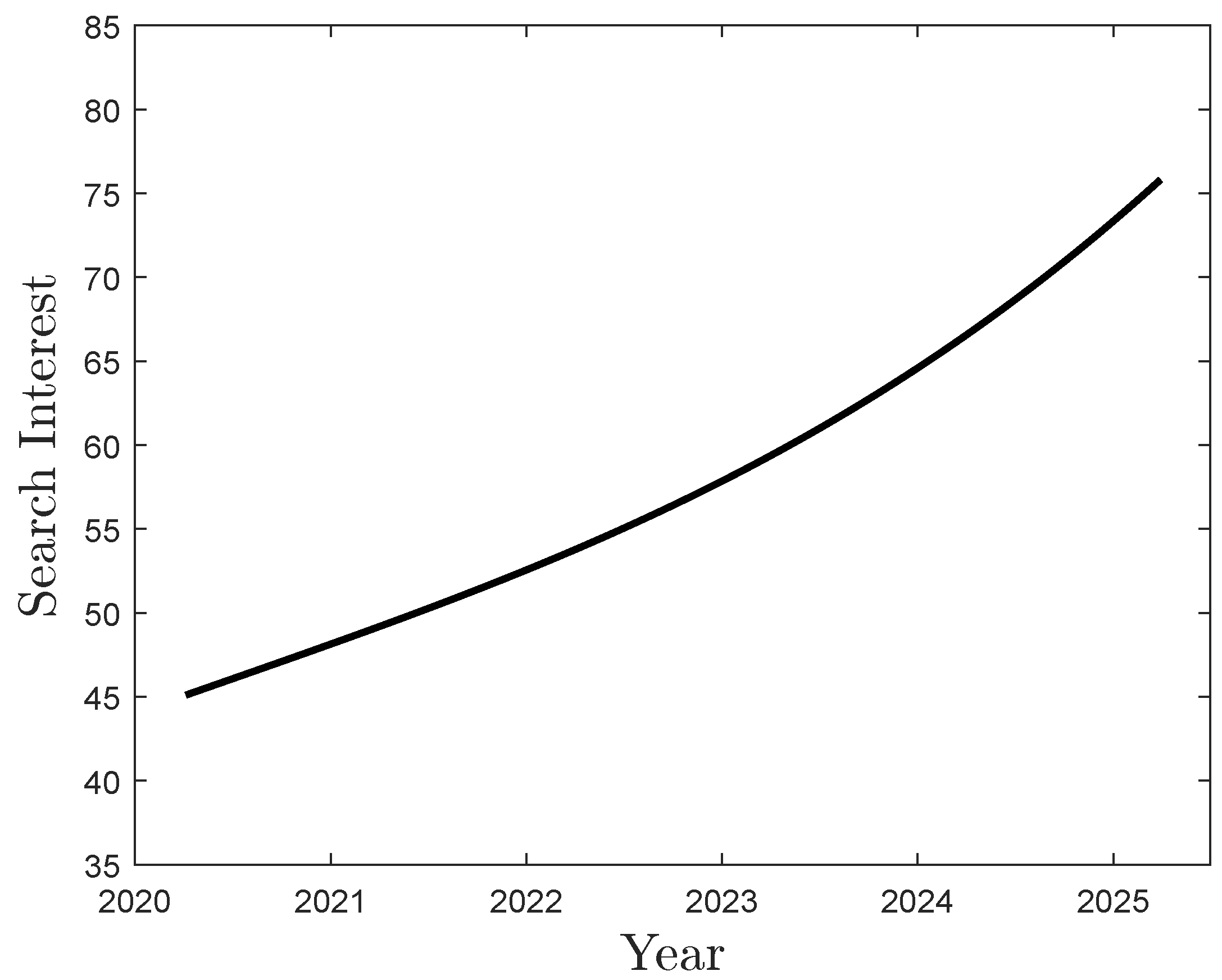
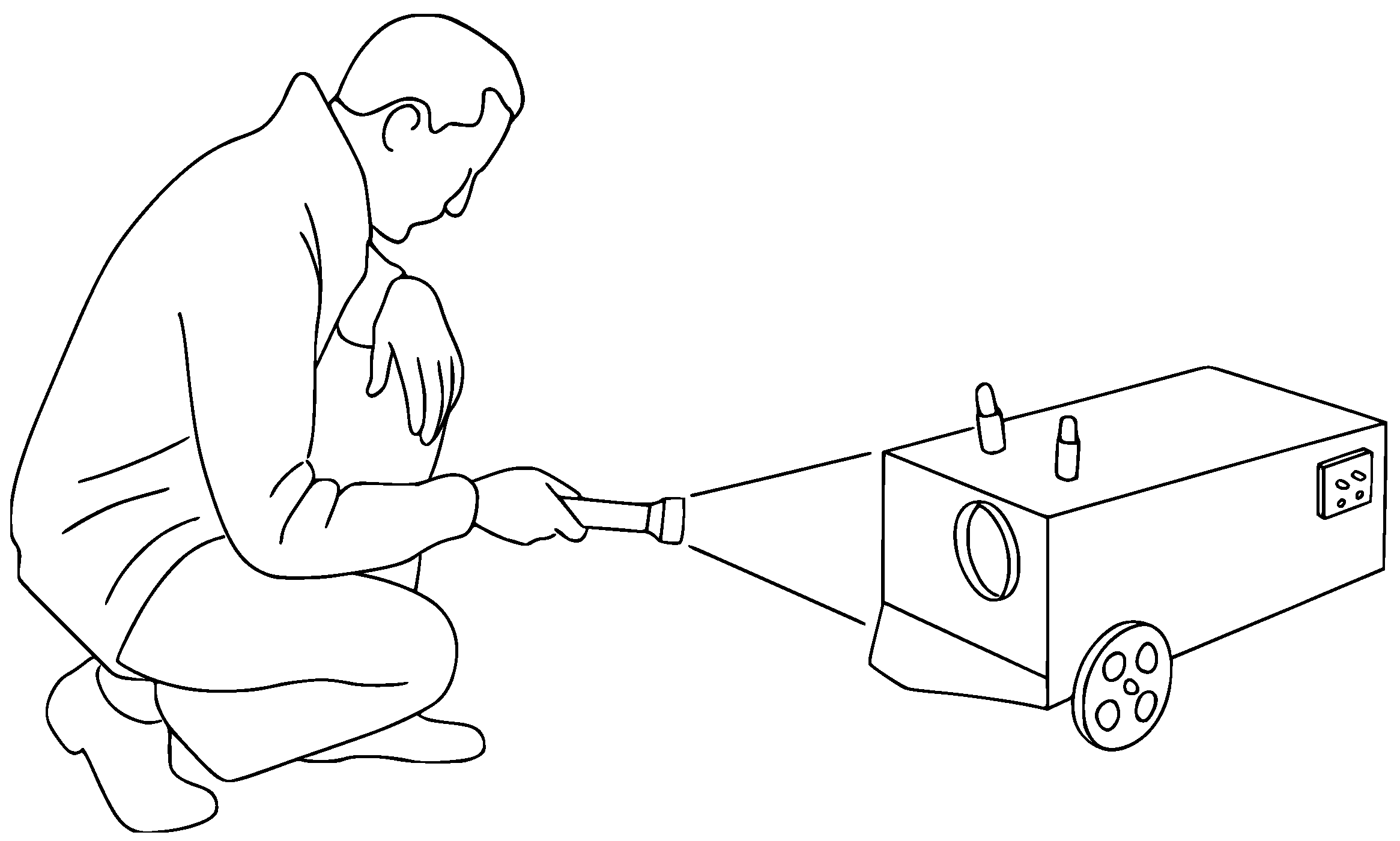


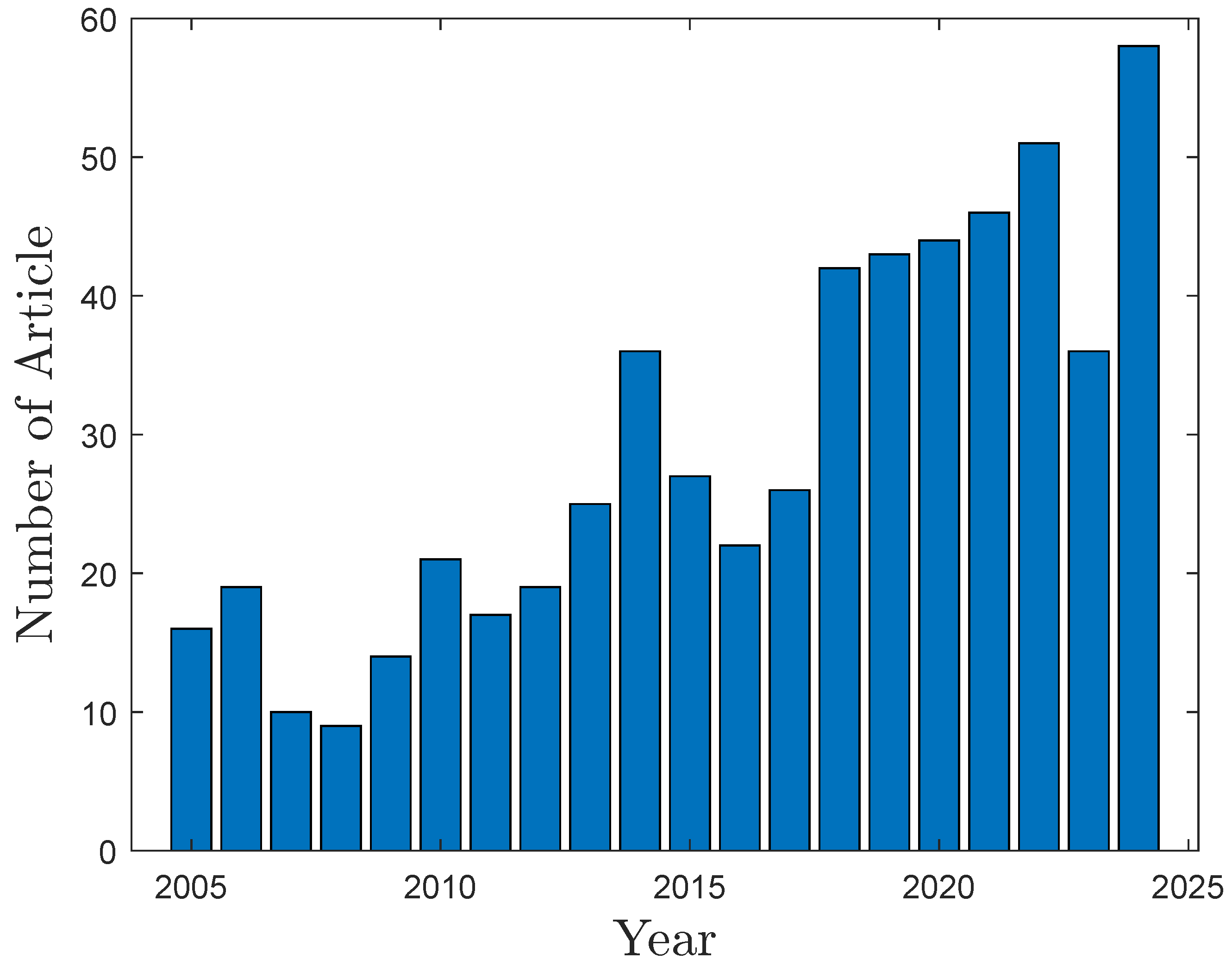

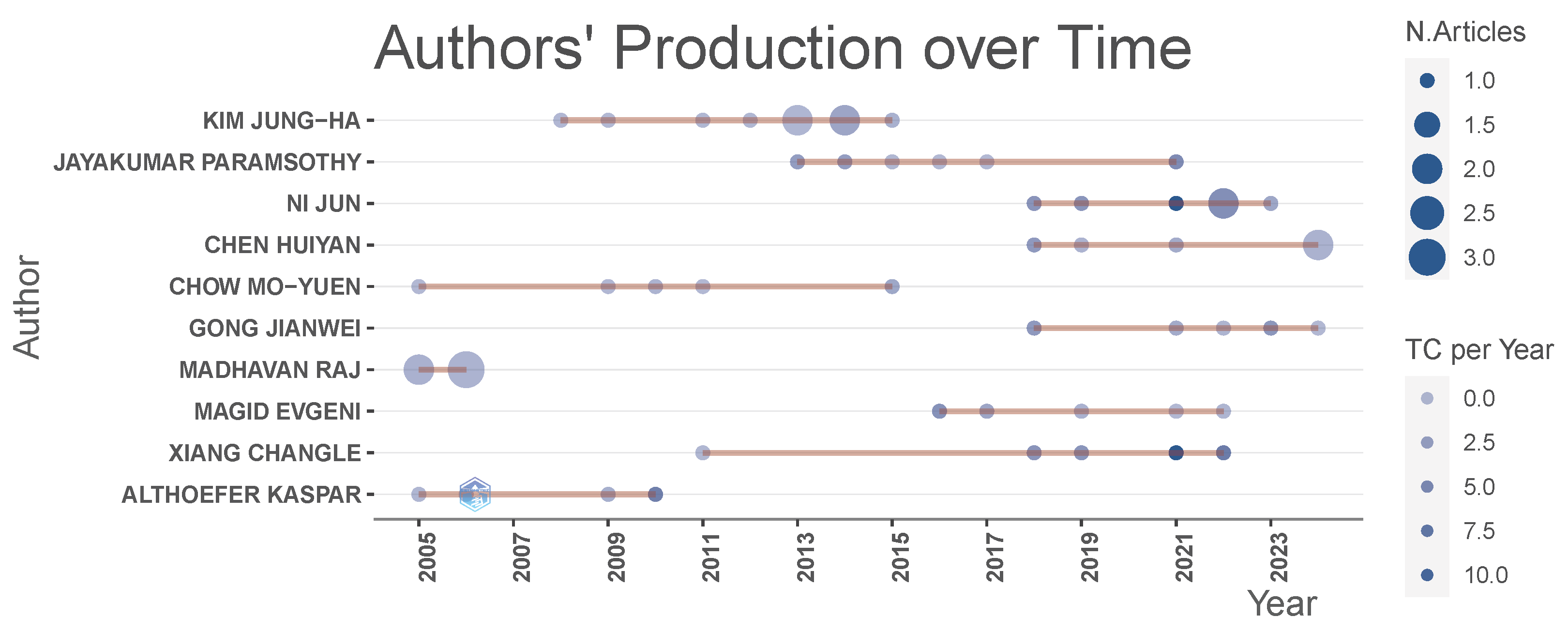


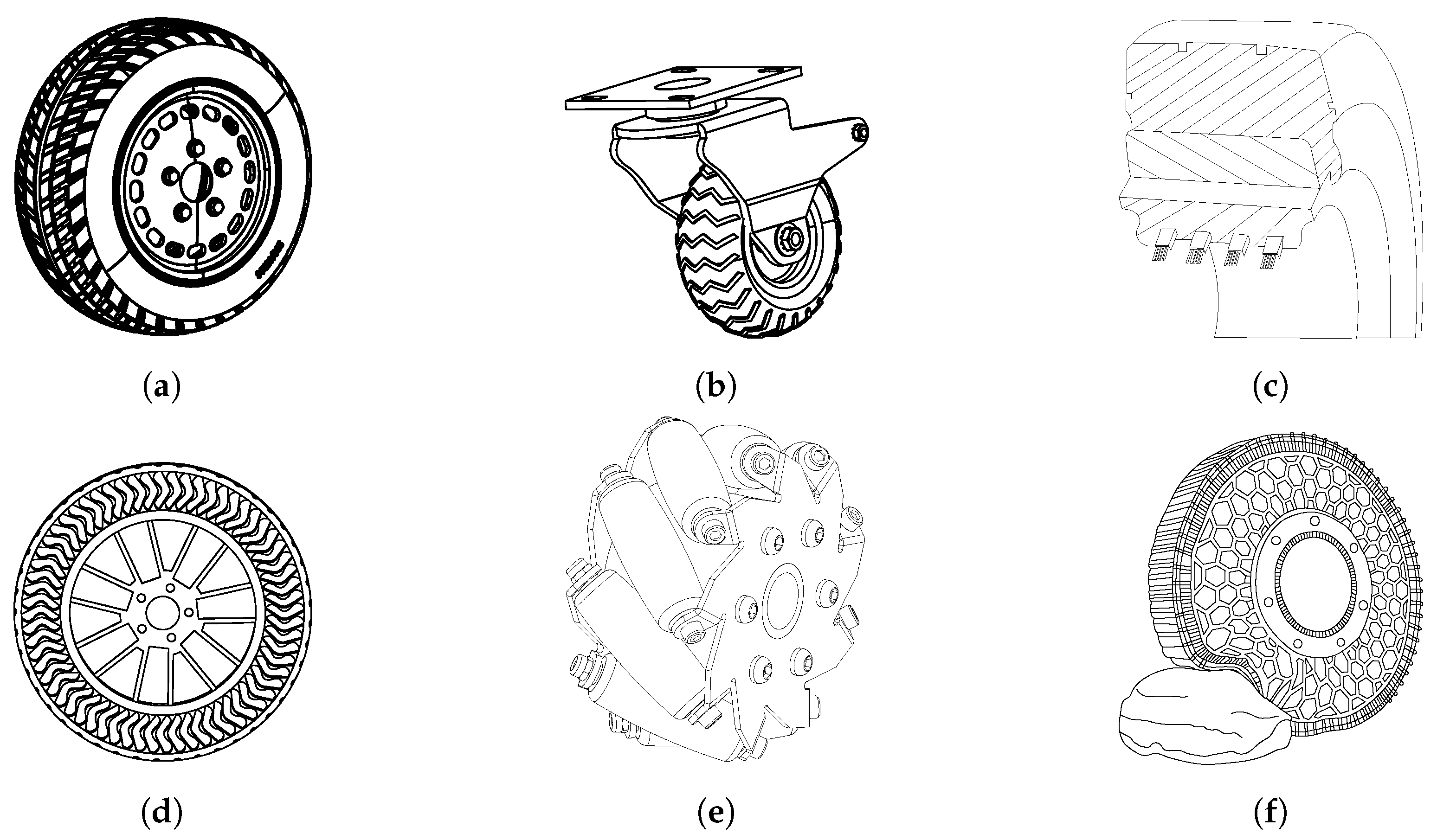
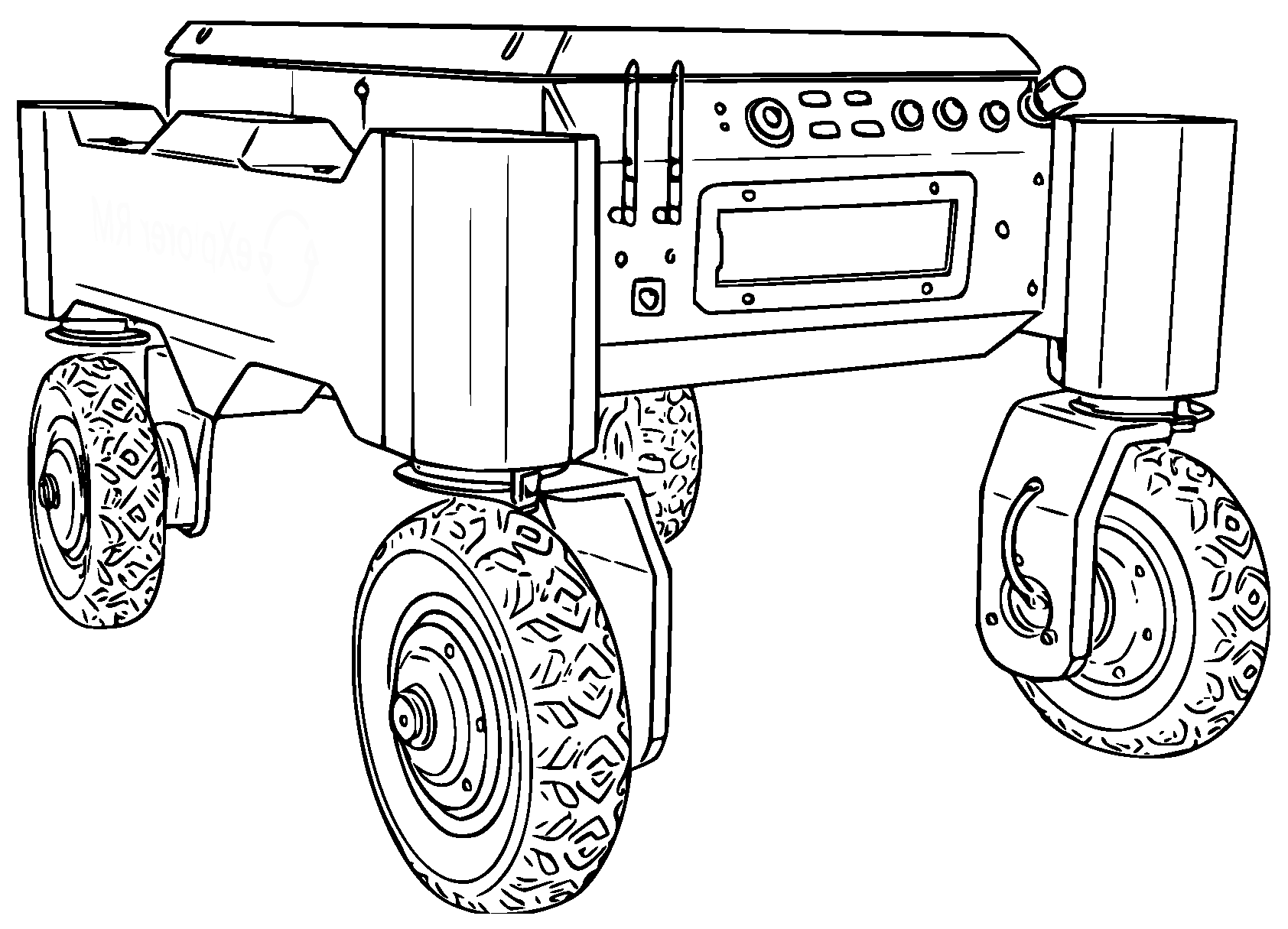

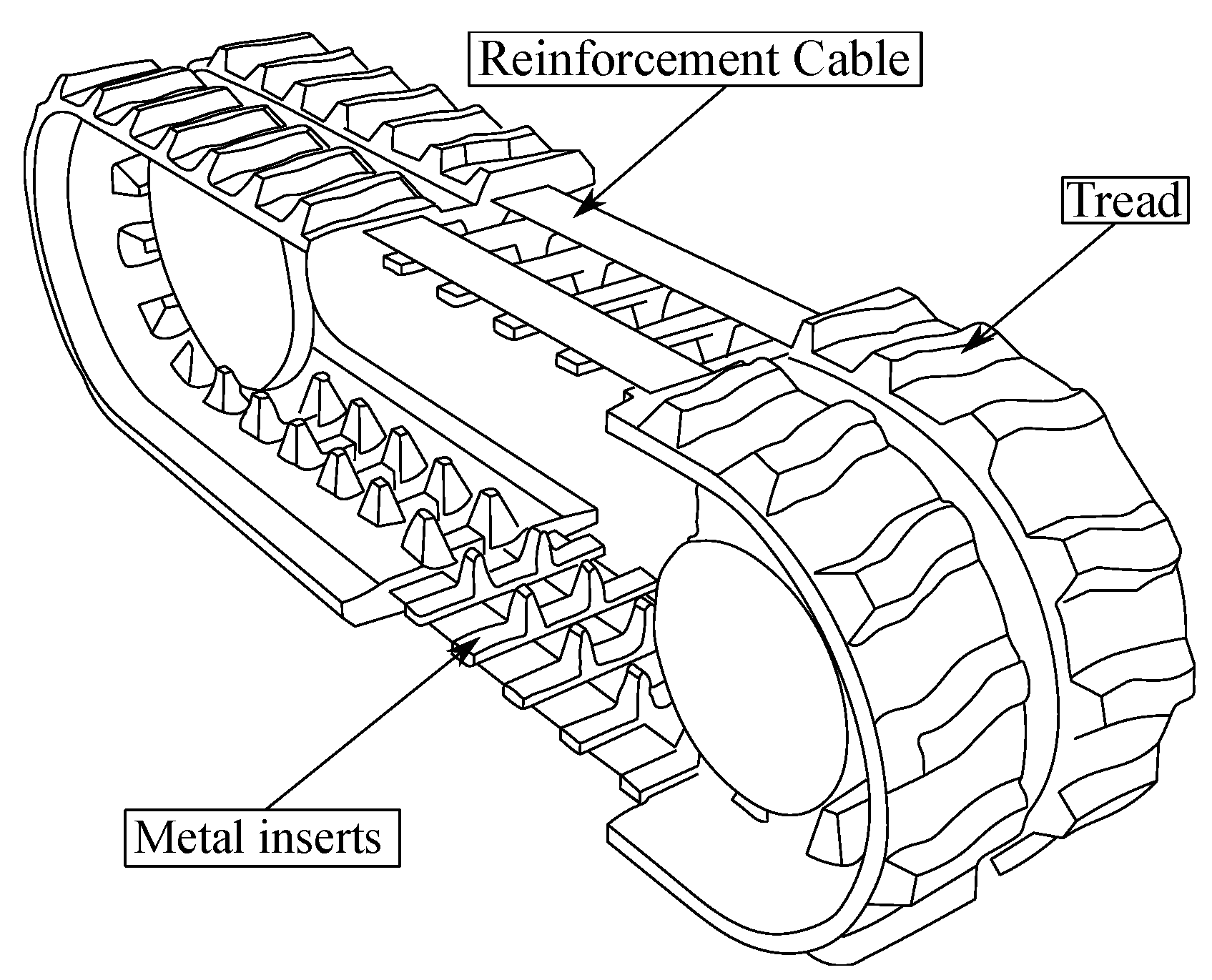
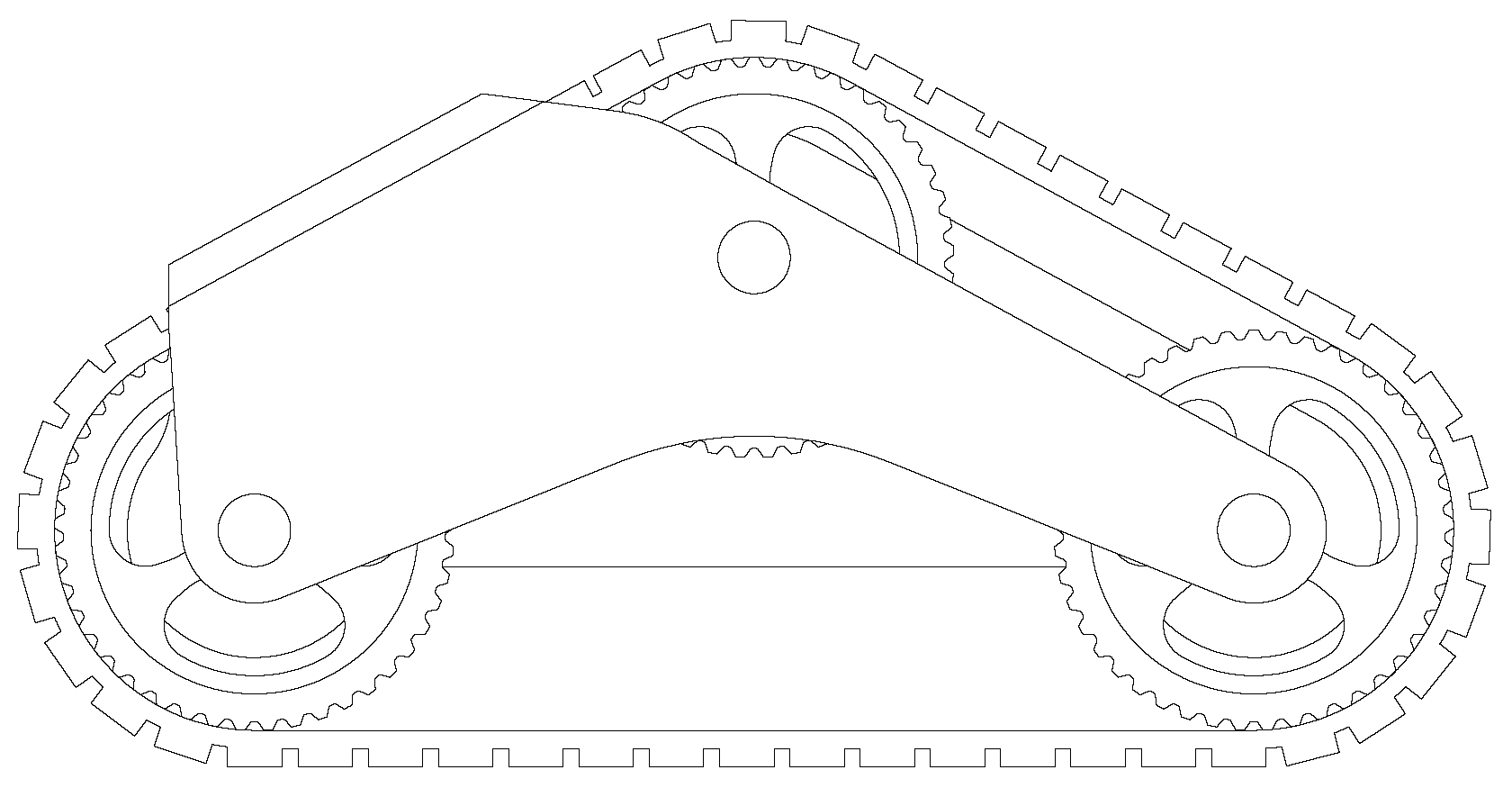
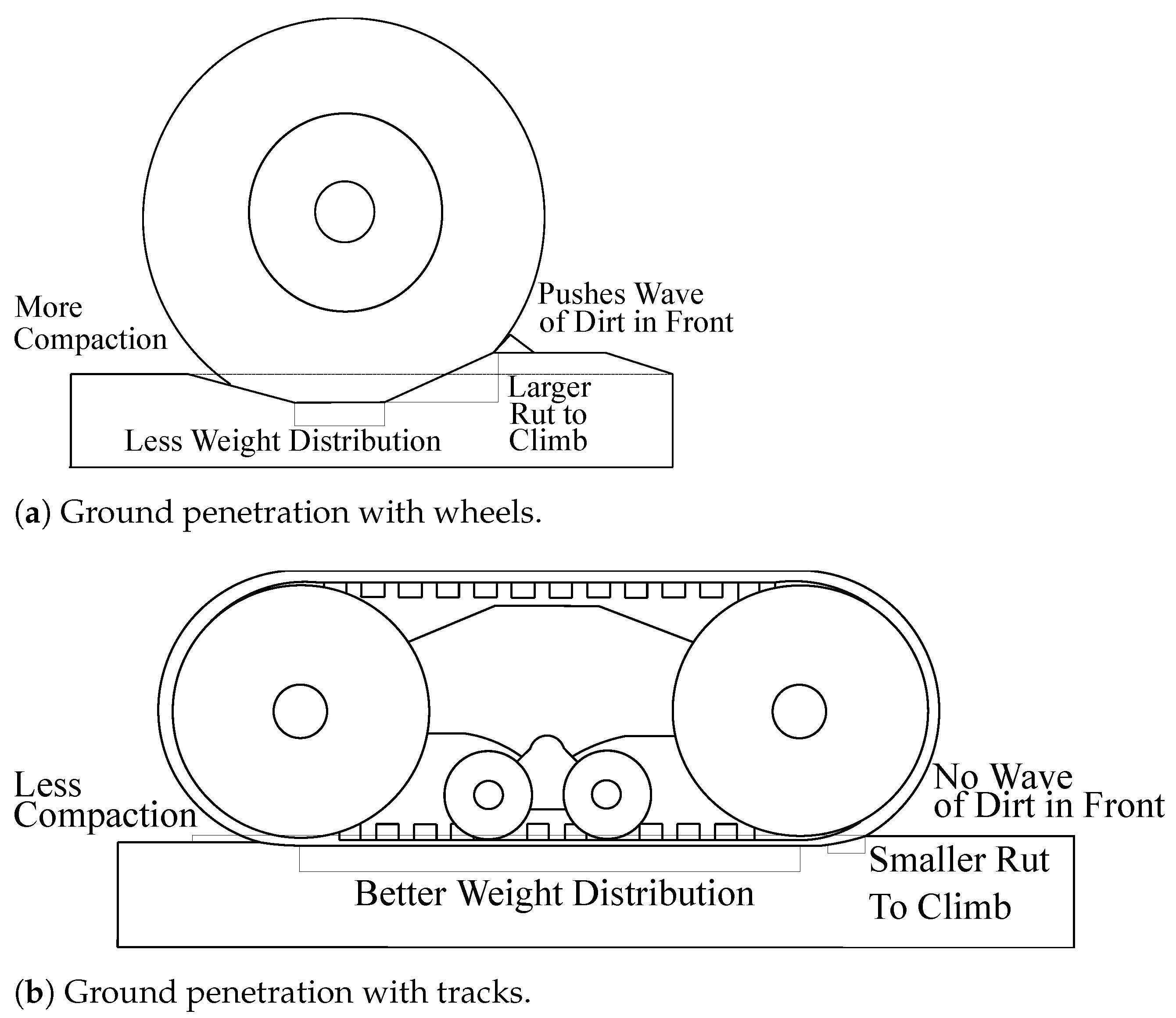
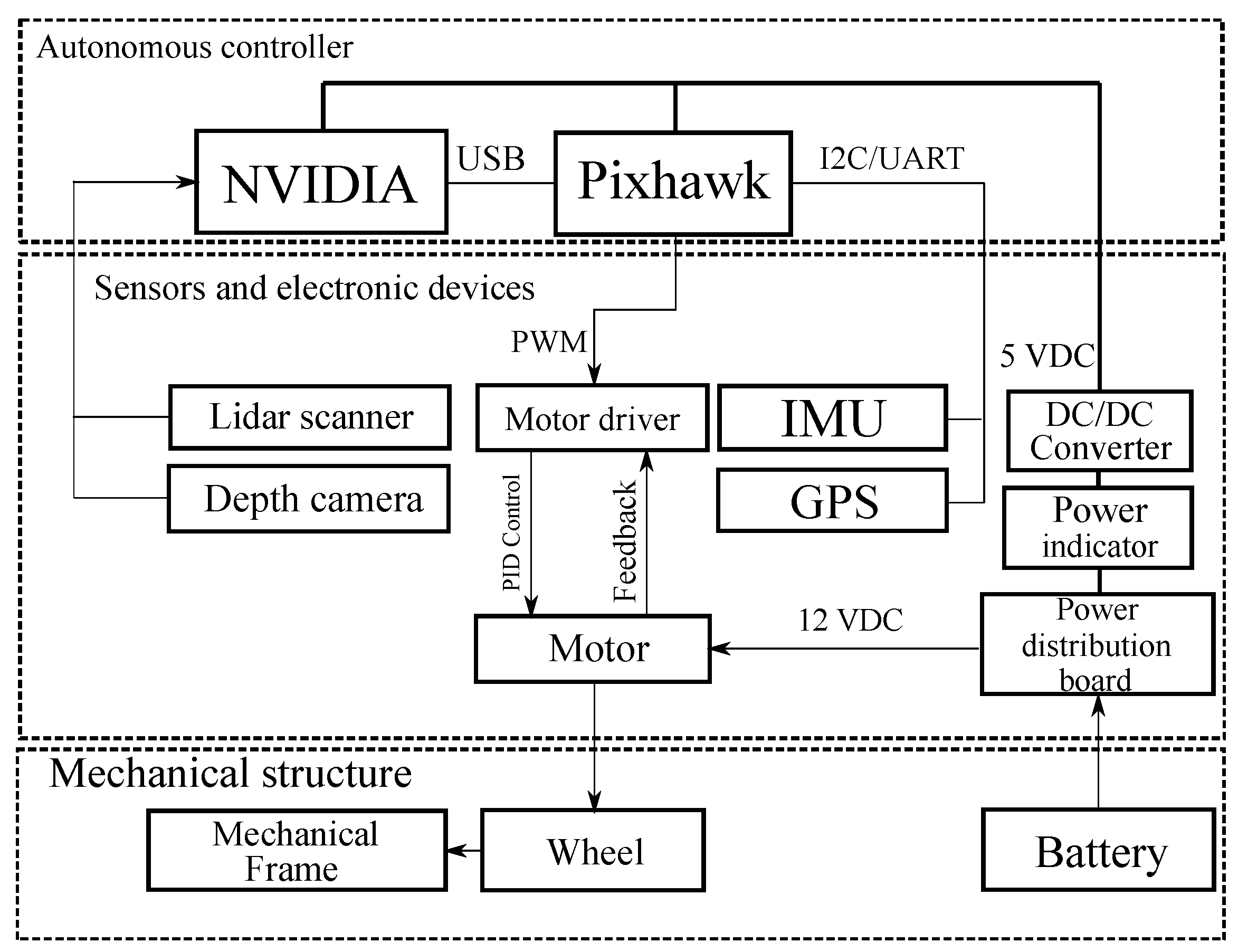

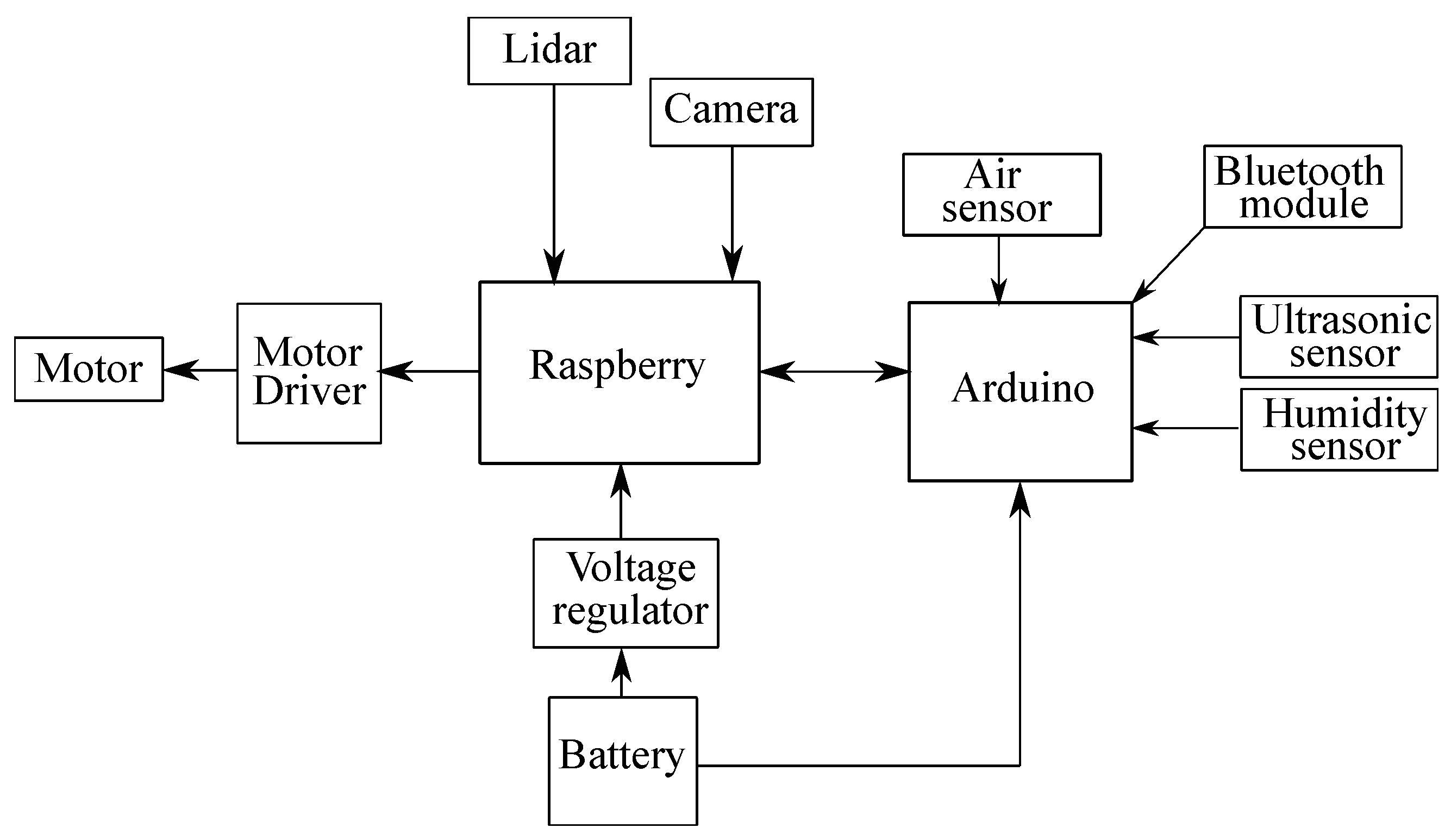

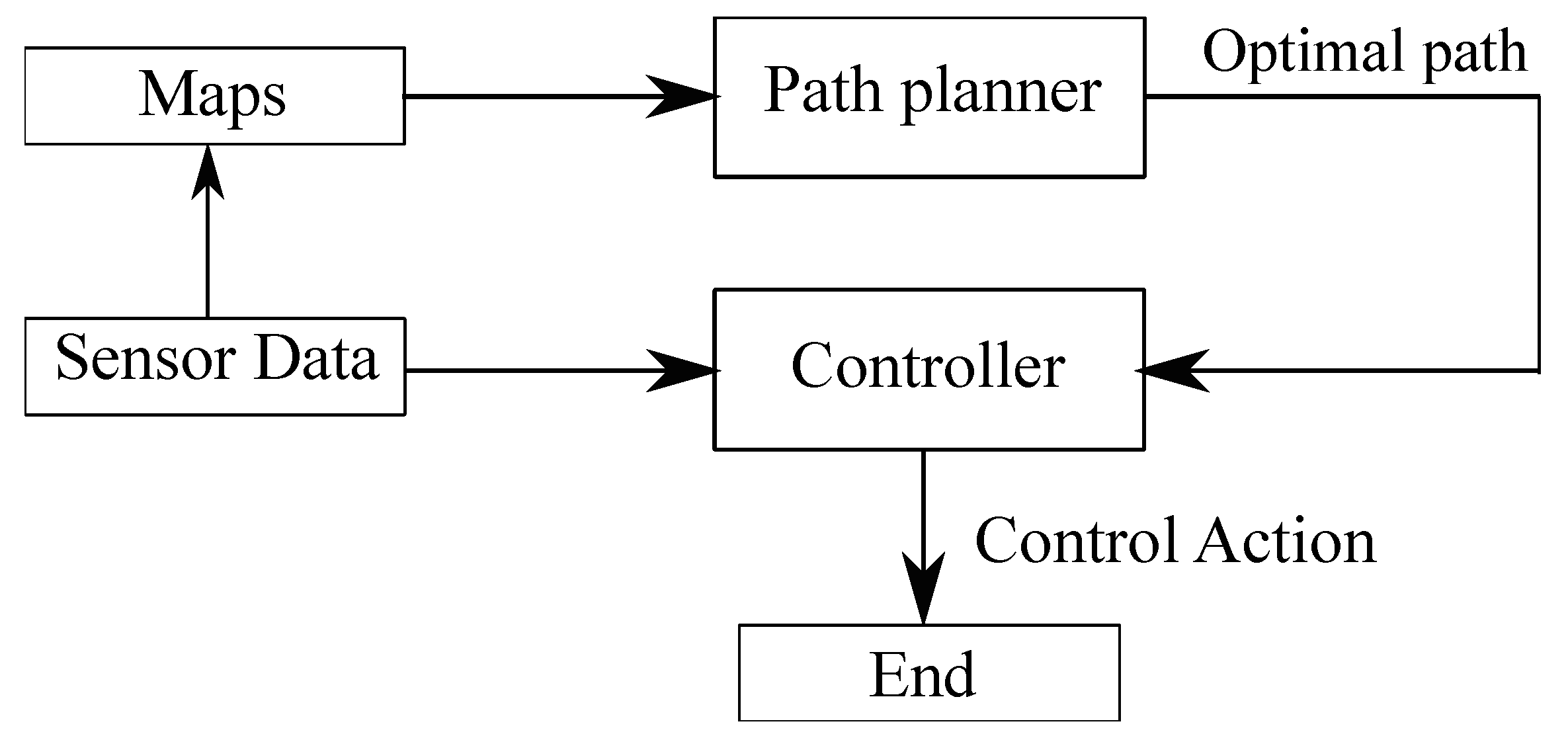


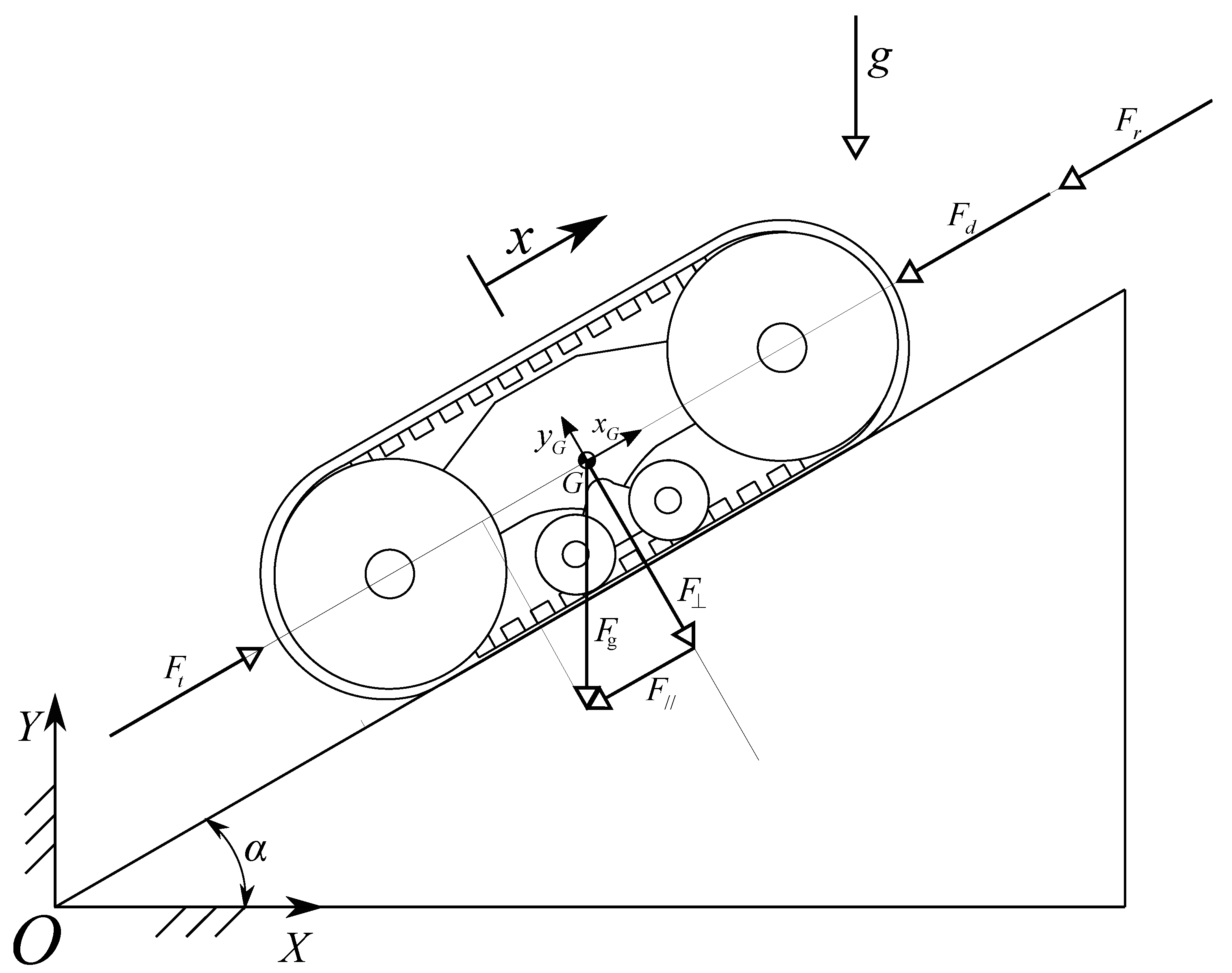

| Main Information About Data | Results |
|---|---|
| Timespan | 2005:2024 |
| Sources (Journals, Books, etc.) | 375 |
| Documents | 581 |
| Average years from publication | 8 |
| Average citations per documents | 13.56 |
| Document Types | Results |
|---|---|
| article | 230 |
| article; early access | 1 |
| article; proceedings paper | 2 |
| conference paper | 184 |
| editorial material | 1 |
| proceedings paper | 157 |
| review | 6 |
| Document contents | Results |
| Keywords Plus (ID) | 2593 |
| Authors Keywords (DE) | 1623 |
| Author | Results |
|---|---|
| Total authors | 1998 |
| Authors of single-authored documents | 6 |
| Authors collaborations | Results |
| Single-authored documents | 6 |
| Average number of Co-Authors per document | 4.08 |
| Most Cited Document | Total Citations | Total Citations per Year |
|---|---|---|
| TOKEKAR P, 2016, IEEE TRANS ROBOT [78] | 324 | 32.40 |
| LI J, 2016, IEEE TRANS VEH TECHNOL [79] | 197 | 19.70 |
| LATTANZI D, 2017, J INFRASTRUCT SYST [80] | 186 | 20.67 |
| CARLSON J, 2005, IEEE TRANS ROBOT [81] | 178 | 8.48 |
| YOON Y, 2009, CONTROL ENG PRACT [82] | 177 | 10.41 |
| LINDEMANN R, 2005, CONF PROC IEEE INT CONF SYST MAN CYBERN [67] | 173 | 8.24 |
| YU H, 2015, IEEE-ASME TRANS MECHATRON [83] | 168 | 15.27 |
| TOROK M, 2014, J COMPUT CIV ENG [84] | 162 | 13.50 |
| WONG J, 2006, J TERRAMECH [85] | 147 | 7.35 |
| QIN H, 2019, IEEE TRANS VEH TECHNOL [86] | 143 | 20.43 |
| Power Supply System | Characteristics | Applications | Advantages | Limitations |
|---|---|---|---|---|
| Internal combustion engine (ICE) + electric motor (EM) | ICE drives an electric generator, while electric motors generate the vehicle motion. | Military and security operations. | Reduces power loss associated with mechanical transmission. | Environmental issues, system complexity, and additional weight. |
| In-Wheel Motors (IWM) | Each wheel is individually driven by an integrated motor. | Military and security operations. | Improved overall system efficiency and modularity. | Low energy storage capacity; difficult power distribution among wheels; requires advanced control strategies. |
| Fuel cell + battery hybrid system | Fuel cell serves as the primary power source, with batteries providing supplementary energy. | Military and security operations. | No restriction on charging, leading to longer system lifetime and improved reliability. | High complexity, elevated cost, and hydrogen storage issues. |
| Hardware System | Characteristics | Applications | Advantages | Limitations |
|---|---|---|---|---|
| NVIDIA Jetson Nano | Compact and powerful embedded computer. | Robotics, image classification, speech processing. | Low cost and energy efficient. | Limited computational power for high-end AI tasks. |
| NVIDIA Jetson TX2 | High-performance and power-efficient computing module. | Manufacturing robots, drones, biomedical systems. | Greater computing power and speed; suitable for complex algorithms. | Higher cost compared to entry-level boards. |
| Pixhawk | Central flight controller with multiple peripheral interfaces. | Unmanned Aerial Vehicles (UAVs) and autonomous systems. | Includes IMU, GPS, radio controller, and battery monitor. | Limited CPU and memory; reduced processing capability. |
| Raspberry Pi | Single-board computer with CPU, RAM, HDMI, USB, and wireless LAN. | Automation, robotics, home servers, computer vision, and education. | Low power consumption, affordable, compact design. | Limited speed, I/O bandwidth, and networking performance in some models. |
| Arduino | Microcontroller-based board with digital and analog I/O ports. | Robotics, IoT, automation, and education. | Low power consumption, cost-effective, easy to program. | Limited memory, low computational capability, lacks real-time performance. |
| Criterion | Tracked | Wheels | Comments |
|---|---|---|---|
| Traction | 5 | 3 | Tracks offer superior traction, especially on low-cohesion surfaces. |
| Terrain adaptability | 5 | 2 | Tracks adapt better to uneven terrain, allowing them to overcome obstacles more easily. |
| Maneuverability | 4 | 3 | Both configurations are maneuverable, but the tracks can perform pivot turning. |
| Energy efficiency | 3 | 5 | Wheels are generally more energy efficient. |
| Speed on flat land | 3 | 5 | Wheels provide higher speeds on flat and firm surfaces. |
| Stability on slopes | 5 | 3 | Tracks ensure greater stability on slopes and slippery surfaces. |
| Ground pressure | 5 | 2 | The larger contact area of the tracks reduces sinking on soft terrain. |
| Mechanical robustness | 4 | 4 | Both systems can be designed to be robust. |
| Maintenance costs | 3 | 4 | Tracked systems require more frequent maintenance compared to wheels. |
| Initial cost | 3 | 5 | Wheeled configurations generally have lower production costs. |
| Total | 38 | 36 | Overall score |
| Symbol | Description | Value (Units) |
|---|---|---|
| m | Mass of the UGV | 600 (kg) |
| v | Maximum speed | 25 (km/h) |
| Rolling friction coefficient | 0.05 (−) | |
| Drag coefficient | 0.8 (−) | |
| A | Frontal area | 0.88 (m2) |
| Air density | 1.225 (kg/m3) | |
| Inclination angle | 0–30.96 (deg) | |
| Percentage slope | 0–60 (%) | |
| Efficiency of electric motor | 0.91 (−) | |
| n | Number of motors | 2 (−) |
| Percentage Slope (%) | Required Power (W) | Maximum Velocity (km/h) |
|---|---|---|
| 0 | 1202.3 | 25 |
| 10 | 4431.4 | 25 |
| 20 | 4899.1 | 22 |
| 30 | 4839.4 | 16 |
| 40 | 4890.6 | 13 |
| 50 | 4868.0 | 11 |
| 60 | 4510.1 | 9 |
| Gear | Number of Teeth (-) | Module (mm) | Pitch Diameter (mm) |
|---|---|---|---|
| a | 16 | 1.25 | 20 |
| c′ | 48 | 1.25 | 60 |
| c″ | 20 | 1.00 | 20 |
| b | 100 | 1.00 | 100 |
Disclaimer/Publisher’s Note: The statements, opinions and data contained in all publications are solely those of the individual author(s) and contributor(s) and not of MDPI and/or the editor(s). MDPI and/or the editor(s) disclaim responsibility for any injury to people or property resulting from any ideas, methods, instructions or products referred to in the content. |
© 2025 by the authors. Licensee MDPI, Basel, Switzerland. This article is an open access article distributed under the terms and conditions of the Creative Commons Attribution (CC BY) license (https://creativecommons.org/licenses/by/4.0/).
Share and Cite
La Regina, R.; Genel, Ö.E.; Pappalardo, C.M.; Guida, D. A Comprehensive Review of Theoretical Advances, Practical Developments, and Modern Challenges of Autonomous Unmanned Ground Vehicles. Machines 2025, 13, 1071. https://doi.org/10.3390/machines13121071
La Regina R, Genel ÖE, Pappalardo CM, Guida D. A Comprehensive Review of Theoretical Advances, Practical Developments, and Modern Challenges of Autonomous Unmanned Ground Vehicles. Machines. 2025; 13(12):1071. https://doi.org/10.3390/machines13121071
Chicago/Turabian StyleLa Regina, Rosario, Ömer Ekim Genel, Carmine Maria Pappalardo, and Domenico Guida. 2025. "A Comprehensive Review of Theoretical Advances, Practical Developments, and Modern Challenges of Autonomous Unmanned Ground Vehicles" Machines 13, no. 12: 1071. https://doi.org/10.3390/machines13121071
APA StyleLa Regina, R., Genel, Ö. E., Pappalardo, C. M., & Guida, D. (2025). A Comprehensive Review of Theoretical Advances, Practical Developments, and Modern Challenges of Autonomous Unmanned Ground Vehicles. Machines, 13(12), 1071. https://doi.org/10.3390/machines13121071







